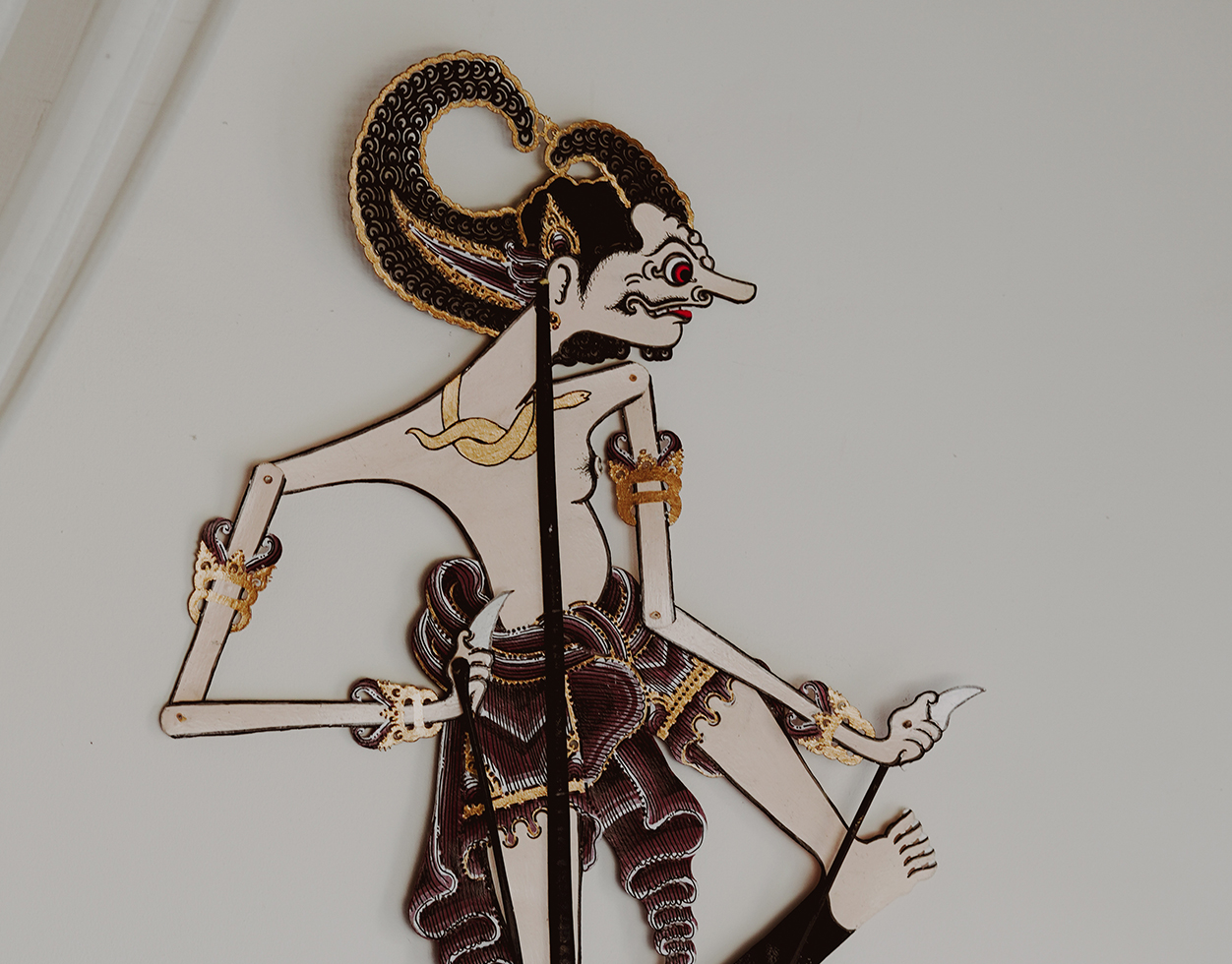
The word Bīma in Sanskrit means fearful, terrific, terrible, awful, formidable, and tremendous. His other names are Dandum Wacana, Kusuma Waligita, Pondan Paksajandu, and Satria Jodipati. Bima was popularly known as Bhimasena, who is equivalent to a formidable army.
Along with other Pandava brothers, Bima was trained in religion, science, administration and military arts by the Kuru preceptors, Kripa and Drona. Specifically, he became a master in using the mace. Bima's strong point throughout the epic remains his towering strength. He was so wrathful and strong that it was impossible to even for Indra to subdue him in a battle.
Bima was also renowned for his giant appetite at times, half of the total food consumed by the Pandavas was eaten by him.
Bima and Hanuman were celestial brothers, as both of them are Vayu's children. He prayed to Vayu and idolized his brother Hanuman. He used to play practical jokes on the Kaurava brothers; he used to engage in wrestling bouts where he out-powered them with consummate ease.
His repeated failures and fecklessness against Bima angered Duryodhana so much that he wanted him dead. He hatched a cunning plot where he poisoned Bima's food and drowned him in river Ganga. Thankfully, the Naga king Vasuki saved Bima and also apprised him of Duryodhana's hatred for him. It is also Vasuki who bestowed him the immense strength of ten thousand elephants.
Duryodhana with his counsellor Purochana hatched a plan to burn the Pandavas alive at a lac palace Lakshagraha at Varnavat that Duryodhana had built there (lacquer is highly inflammable). Thanks to prior notice from Vidura, the Pandavas managed to escape out from the palace with Bima played a major role in carrying all five of them (Kunti and brothers) and escaping to safety. Bima also barricaded the palace of Purochana and set fire to it, thereby ensuring Purochana became a victim of his own evil plot.
Kunti and the Pandavas were living in agyatavaasa (living incognito) after they escaped from the murder plot (Kunti suggests they be incognito to avoid further problems from the Kauravas). During their stay at Ekachakra village (present-day Kaivara), they came to know of a demon, Bakasura, who troubled people by eating members of their village and their provisions. The powerful Bima brought his might to the fore and killed Bakasura, much to the delight of the villagers.
At the time Bima kills the demon Hidimba who was king of demons of the forest Kamyaka, he meets his sister Hidimbi; they eventually get married and have a son, Gatotkaca. Hidimbi promises Kunti that she and Gatotkaca will stay out of the Pandavas' lives and away from the luxuries of court.
When Bima killed the demon Hidimba, he became the King of Kamyaka for 5 years. In Mahabharata, the demon army from Kamyaka fought the war alongside Pandavas.
The Pandavas attended the Swayamvara of Drupada princess, Drupadi. The Pandavas, led by Arjuna, were successful at the Swayamvara. With his brothers, he was married to Drupadi, who gave birth to a son, Sutasoma. At a later stage, Bima also married princess Valandhara, the daughter of the king of Kasi, and had a son named Savarga.
Among Bima's three sons, Sarvaga (who later ascended to the throne of Kashi) did not participate in the Kurukshetra war, Sutasoma was killed by Ashwatthama and Gatotkaca was killed by Karna.
After the war, Dhritarashtra was enraged by Bima's slaying of all his sons. When the Pandavas arrive at Hastinapur to claim the kingdom and pay their respects, Krishna, sensing his anger, placed an iron statue of Bima in front of Dhritarashtra. When embracing Bima, Dhritarashtra crushed the statue into pieces, but later realized his folly and apologized. He later hugged Bima wholeheartedly.
Yudhishthira appointed Bima as the commander-in-chief of Hastinapur. Upon the onset of the Kali Yuga, Bima and the other Pandavas retired. Giving up all their belongings and ties, the Pandavas made their final journey of pilgrimage to the Himalayas.
On the journey, the group, one by one, begins to fall. When Bima tires and falls down, he asks his elder brother why he, Bima, is unable to complete the journey to heaven. Yudhistira explains his brother's vice of gluttony. In some versions of the story, Yudhistira points out Bima's boastfulness, pride, and battle-lust as the reasons for his fall.

The word Bīma in Sanskrit means fearful, terrific, terrible, awful, formidable, and tremendous. His other names are Dandum Wacana, Kusuma Waligita, Pondan Paksajandu, and Satria Jodipati. Bima was popularly known as Bhimasena, who is equivalent to a formidable army.
Along with other Pandava brothers, Bima was trained in religion, science, administration and military arts by the Kuru preceptors, Kripa and Drona. Specifically, he became a master in using the mace. Bima's strong point throughout the epic remains his towering strength. He was so wrathful and strong that it was impossible to even for Indra to subdue him in a battle.
Bima was also renowned for his giant appetite at times, half of the total food consumed by the Pandavas was eaten by him.
Bima and Hanuman were celestial brothers, as both of them are Vayu's children. He prayed to Vayu and idolized his brother Hanuman. He used to play practical jokes on the Kaurava brothers; he used to engage in wrestling bouts where he out-powered them with consummate ease.
His repeated failures and fecklessness against Bima angered Duryodhana so much that he wanted him dead. He hatched a cunning plot where he poisoned Bima's food and drowned him in river Ganga. Thankfully, the Naga king Vasuki saved Bima and also apprised him of Duryodhana's hatred for him. It is also Vasuki who bestowed him the immense strength of ten thousand elephants.
Duryodhana with his counsellor Purochana hatched a plan to burn the Pandavas alive at a lac palace Lakshagraha at Varnavat that Duryodhana had built there (lacquer is highly inflammable). Thanks to prior notice from Vidura, the Pandavas managed to escape out from the palace with Bima played a major role in carrying all five of them (Kunti and brothers) and escaping to safety. Bima also barricaded the palace of Purochana and set fire to it, thereby ensuring Purochana became a victim of his own evil plot.
Kunti and the Pandavas were living in agyatavaasa (living incognito) after they escaped from the murder plot (Kunti suggests they be incognito to avoid further problems from the Kauravas). During their stay at Ekachakra village (present-day Kaivara), they came to know of a demon, Bakasura, who troubled people by eating members of their village and their provisions. The powerful Bima brought his might to the fore and killed Bakasura, much to the delight of the villagers.
At the time Bima kills the demon Hidimba who was king of demons of the forest Kamyaka, he meets his sister Hidimbi; they eventually get married and have a son, Gatotkaca. Hidimbi promises Kunti that she and Gatotkaca will stay out of the Pandavas' lives and away from the luxuries of court.
When Bima killed the demon Hidimba, he became the King of Kamyaka for 5 years. In Mahabharata, the demon army from Kamyaka fought the war alongside Pandavas.
The Pandavas attended the Swayamvara of Drupada princess, Drupadi. The Pandavas, led by Arjuna, were successful at the Swayamvara. With his brothers, he was married to Drupadi, who gave birth to a son, Sutasoma. At a later stage, Bima also married princess Valandhara, the daughter of the king of Kasi, and had a son named Savarga.
Among Bima's three sons, Sarvaga (who later ascended to the throne of Kashi) did not participate in the Kurukshetra war, Sutasoma was killed by Ashwatthama and Gatotkaca was killed by Karna.
After the war, Dhritarashtra was enraged by Bima's slaying of all his sons. When the Pandavas arrive at Hastinapur to claim the kingdom and pay their respects, Krishna, sensing his anger, placed an iron statue of Bima in front of Dhritarashtra. When embracing Bima, Dhritarashtra crushed the statue into pieces, but later realized his folly and apologized. He later hugged Bima wholeheartedly.
Yudhishthira appointed Bima as the commander-in-chief of Hastinapur. Upon the onset of the Kali Yuga, Bima and the other Pandavas retired. Giving up all their belongings and ties, the Pandavas made their final journey of pilgrimage to the Himalayas.
On the journey, the group, one by one, begins to fall. When Bima tires and falls down, he asks his elder brother why he, Bima, is unable to complete the journey to heaven. Yudhistira explains his brother's vice of gluttony. In some versions of the story, Yudhistira points out Bima's boastfulness, pride, and battle-lust as the reasons for his fall.
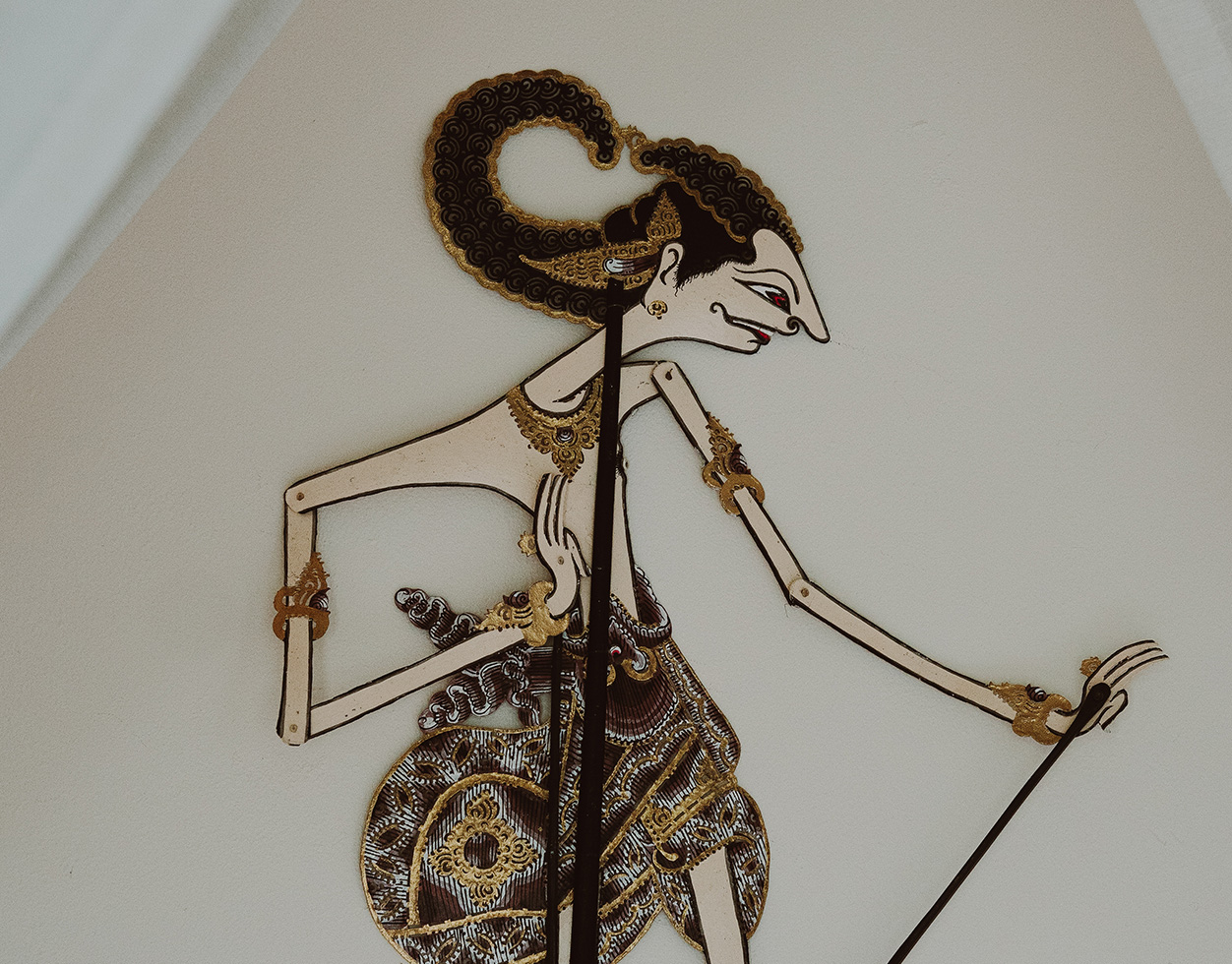
According to Monier Monier-Williams, the word Arjuna means white, clear or silver. He is known by many other names, such as:
Arjuna was one of the five Pandava brothers of royal lineage, whose collective name derives from their father and heir to the Lunar dynasty, Pandu. However, Pandu was under a curse whereby he would die if he had sexual relations with a woman, and thus his sons were born using a mantra given to Kunti by sage Durvasa during her maiden days. His wives Madri and Kunti invoked different gods and were blessed with children.
According to the legend, Arjuna was a demigod, who was born as a blessing after his mother Kunti invoked the god Indra at her husband's request. The Mahabharata and Puranas such as Devi Bhagavata also record Arjuna as a reincarnation of a rishi called Nara.
Despite being the younger brother of Dhritarashtra, it was Pandu who succeeded their father as king of Bharata. This was because Dhritarashtra was blind, a disability that caused him to forfeit his right to royal succession. Dhritarashtra fathered 100 sons, known as the Kaurava brothers, and ascended the throne on the death of Pandu. The Pandava brothers were then brought up with their cousins, the Kauravas, and the education of all these boys was supervised by Bhishma.
Among their teachers was the Brahmin warrior called Drona, who considered Arjuna to be his favorite. According to Swami Parmeshwaranand, Arjuna was Drona's most accomplished pupil. He notes an incident where Drona deemed that out of all his students, none but Arjuna had the steadfast focus to shoot the eye of a toy bird on a tree using a bow and arrow, and that Drona was proven right.
Arjuna is a central character in the Hindu epics and appears in hundreds of situations. Among the most notable is his marriage to Drupadi, the fire born daughter of Drupada, who was the king of Panchala.
After the event of Lakshagriha, Arjuna, his mother and brothers decide to hide from Hastinapura. One day, Arjuna learns that Drupada is holding an archery tournament to determine who should marry his daughter.
The tournament was to lift and string a bow, and fire arrows to pierce the eye of a golden fish only by looking at its reflection in the water. At the Swayamvara, almost all the assorted monarchs were unable to complete the challenge. In the end, Arjuna, dressed as a Brahmin, wins the tournament. Annoyed by their defeat, the kings attack Arjuna, but he defeats them and runs home to tell his mother of his success, shouting "look what we have found". Commentators vary as to whether Kunti thought he was referring to alms found in the forest or to some great prize unknown to her. She tells him that the find must be shared with his brothers, as they had always shared such things in the past.
This misunderstanding, combined with the protocol that the oldest of the brothers, Yudhistira, should marry first, leads to the agreement that all five brothers marry her. This is one of the rare examples of polyandry in Sanskrit literature. The brothers agreed that none should intrude if Drupadi was alone with one of the others, the penalty for doing so is a year to be spent in exile during which the culprit must remain celibate.
When Arjuna, his siblings, mother and Drupadi returned to Hastinapura, Dhritarashtra determined to avoid a rivalry developing for control of Hastinapur by splitting the kingdom, with half of it being left to his own eldest son, Duryodhana, and half to the eldest son of Pandu, Yudhishtira. Arjuna inadvertently broke the pact with his brothers, intruding as he sought to collect weapons whilst Yudhistira, was alone with Drupadi. He felt obliged to go into exile despite Yudhishtira's attempts to dissuade him. It was this event that led to him forming a close relationship with his cousin Krishna because he ignored the celibacy condition of the pact and married three people on his travels, the first of whom was a Naga princess named Ulupi, with whom he had a son called Iravan.
His second marriage was with a princess of Manipura, Chitrangada, who bore a son named Babhruvahana. The third was with Subhadra, the sister of Krishna. This last event, which took place in Dvaraka, is not the first meeting between Krishna and the Pandavas in the story but it does mark the start of a bond, sealed with the birth of the couple's child, Abhimanyu, whom Krishna adores.
After the Kurukshetra War, Yudhishtira appointed Arjuna as the Prime Minister of Hastinapur. Yudhishthira performed Ashvamedha. Arjuna followed the horse to the land of Manipura and encountered Babhruvahana, one of his sons. None of them knew one another.
Babhruvahana asked Arjuna to fight and killed his father during the battle. Chitrāngadā came to the battlefield and revealed that Arjuna was her husband and Babhruvahana's father. Ulupi, the second wife of Arjuna, revived Arjuna using a celestial gem called Nagamani.
After Krishna left his mortal body, Arjuna took the citizens of Dwaraka, including 16,100 wives of Krishna, to Indraprastha. On the way, they were attacked by a group of bandits. Arjuna desisted fighting seeing the law of time. Upon the onset of the Kali Yuga and acting on the advice of Vyasa, Arjuna and other Pandavas retired, leaving the throne to Parikshit (Arjuna's grandson and Abhimanyu's son).
Giving up all their belongings and ties, the Pandavas, accompanied by a dog, made their final journey of pilgrimage to the Himalayas. The listener of the Mahabharata is Janamejaya, Parikshit's son and Arjunaś great-grandson.

According to Monier Monier-Williams, the word Arjuna means white, clear or silver. He is known by many other names, such as:
Arjuna was one of the five Pandava brothers of royal lineage, whose collective name derives from their father and heir to the Lunar dynasty, Pandu. However, Pandu was under a curse whereby he would die if he had sexual relations with a woman, and thus his sons were born using a mantra given to Kunti by sage Durvasa during her maiden days. His wives Madri and Kunti invoked different gods and were blessed with children.
According to the legend, Arjuna was a demigod, who was born as a blessing after his mother Kunti invoked the god Indra at her husband's request. The Mahabharata and Puranas such as Devi Bhagavata also record Arjuna as a reincarnation of a rishi called Nara.
Despite being the younger brother of Dhritarashtra, it was Pandu who succeeded their father as king of Bharata. This was because Dhritarashtra was blind, a disability that caused him to forfeit his right to royal succession. Dhritarashtra fathered 100 sons, known as the Kaurava brothers, and ascended the throne on the death of Pandu. The Pandava brothers were then brought up with their cousins, the Kauravas, and the education of all these boys was supervised by Bhishma.
Among their teachers was the Brahmin warrior called Drona, who considered Arjuna to be his favorite. According to Swami Parmeshwaranand, Arjuna was Drona's most accomplished pupil. He notes an incident where Drona deemed that out of all his students, none but Arjuna had the steadfast focus to shoot the eye of a toy bird on a tree using a bow and arrow, and that Drona was proven right.
Arjuna is a central character in the Hindu epics and appears in hundreds of situations. Among the most notable is his marriage to Drupadi, the fire born daughter of Drupada, who was the king of Panchala.
After the event of Lakshagriha, Arjuna, his mother and brothers decide to hide from Hastinapura. One day, Arjuna learns that Drupada is holding an archery tournament to determine who should marry his daughter.
The tournament was to lift and string a bow, and fire arrows to pierce the eye of a golden fish only by looking at its reflection in the water. At the Swayamvara, almost all the assorted monarchs were unable to complete the challenge. In the end, Arjuna, dressed as a Brahmin, wins the tournament. Annoyed by their defeat, the kings attack Arjuna, but he defeats them and runs home to tell his mother of his success, shouting "look what we have found". Commentators vary as to whether Kunti thought he was referring to alms found in the forest or to some great prize unknown to her. She tells him that the find must be shared with his brothers, as they had always shared such things in the past.
This misunderstanding, combined with the protocol that the oldest of the brothers, Yudhistira, should marry first, leads to the agreement that all five brothers marry her. This is one of the rare examples of polyandry in Sanskrit literature. The brothers agreed that none should intrude if Drupadi was alone with one of the others, the penalty for doing so is a year to be spent in exile during which the culprit must remain celibate.
When Arjuna, his siblings, mother and Drupadi returned to Hastinapura, Dhritarashtra determined to avoid a rivalry developing for control of Hastinapur by splitting the kingdom, with half of it being left to his own eldest son, Duryodhana, and half to the eldest son of Pandu, Yudhishtira. Arjuna inadvertently broke the pact with his brothers, intruding as he sought to collect weapons whilst Yudhistira, was alone with Drupadi. He felt obliged to go into exile despite Yudhishtira's attempts to dissuade him. It was this event that led to him forming a close relationship with his cousin Krishna because he ignored the celibacy condition of the pact and married three people on his travels, the first of whom was a Naga princess named Ulupi, with whom he had a son called Iravan.
His second marriage was with a princess of Manipura, Chitrangada, who bore a son named Babhruvahana. The third was with Subhadra, the sister of Krishna. This last event, which took place in Dvaraka, is not the first meeting between Krishna and the Pandavas in the story but it does mark the start of a bond, sealed with the birth of the couple's child, Abhimanyu, whom Krishna adores.
After the Kurukshetra War, Yudhishtira appointed Arjuna as the Prime Minister of Hastinapur. Yudhishthira performed Ashvamedha. Arjuna followed the horse to the land of Manipura and encountered Babhruvahana, one of his sons. None of them knew one another.
Babhruvahana asked Arjuna to fight and killed his father during the battle. Chitrāngadā came to the battlefield and revealed that Arjuna was her husband and Babhruvahana's father. Ulupi, the second wife of Arjuna, revived Arjuna using a celestial gem called Nagamani.
After Krishna left his mortal body, Arjuna took the citizens of Dwaraka, including 16,100 wives of Krishna, to Indraprastha. On the way, they were attacked by a group of bandits. Arjuna desisted fighting seeing the law of time. Upon the onset of the Kali Yuga and acting on the advice of Vyasa, Arjuna and other Pandavas retired, leaving the throne to Parikshit (Arjuna's grandson and Abhimanyu's son).
Giving up all their belongings and ties, the Pandavas, accompanied by a dog, made their final journey of pilgrimage to the Himalayas. The listener of the Mahabharata is Janamejaya, Parikshit's son and Arjunaś great-grandson.

Sahadewa was the youngest of the Pandava brothers, the five principal protagonists of the epic Mahabharata. He and his twin brother, Nakula, were blessed to King Pandu and Queen Madri by invoking the twin gods Ashvins. Trained by Drona, Kripa and Brihaspati, Sahadewa is described to be skilled in swordsmanship and astrology, and also Neeti Sastra. He went on a war campaign to southern part of India to subjugate kingdoms for the Rajasuya sacrifice, after crowning his Pandava brother Yudhistira as the emperor of Indraprastha.
He was exiled for 13 years along with his Pandava brothers, when Yudhistira lost all his possessions, his brothers, and their common wife Drupadi to Duryodhana of Kuru Kingdom of Hastinapur during a dice game played by the vily Shakuni, the maternal uncle of Duryodhana.
During his one year incognito living, as part of 13 years exile, he disguised as a cowherd and served in the Kingdom of Virata. During the 18-days Kurukshetra War, he slew many warriors including Shakuni. After the war, Yudhishthira appointed Sahadewa as the king of southern Madra. During his final journey of pilgrimage to the Himalayas, he succumbed en route, after Drupadi.
The word sahadewa is derived from two Sanskrit words saha and dewa. Saha means with and dewa is a Hindu term used for deity. So literally, Sahadewa means with Gods. Another meaning is thousand Gods. Sahadewa and his brother Nakula, are both called as Ashvineya, as they were born from Ashvins. In southern India, he was regarded as a very accomplished astrologer, a face reader, and all other forms of intuitive perception, but because of his secretive nature in revealing anything though full knowing the situation he is called "Sahadewa" colloquially.
Due to Pandu's inability to bear children (because of the curse of rishi Kindama), Madri had to use the boon given to Kunti by sage Durvasa to give birth, who invoked the Ashwini Kumaras to beget Nakula and Sahadewa. Though they were twins, they had altogether different characteristics, physically and mentally. Nakula was born at sunrise while Sahadewa was born at sunset. Sahadewa was an occultist and Nakula was an Ayurvedic physician but both very valiant in warfare in archery and deft use of swords. When Nakula and Sahadewa were born, a divine voice had proclaimed: "these virtuos and accomplished sons will transcend in energy and beauty even their celestial fathers."
Later, Pandu died due to his Kindama's curse when he attempted to make love with his wife. Madri handed over her children to Kunti and committed sati. Kunti raised him along with his brothers in Hastinapur with love and care. It is believed that Sahadewa was Kunti's favourite Pandava, in spite of not being her biological son. The Pandava brothers along with their mother Kunti were escorted from their forest dwelling by Bhishma to Hastinapur to live with their uncle King Dhritarashtra who ruled over the Kuru Kingdom. There is also a story that Pandu, father of Pandavas, when he was about to die had a premonition of his death revealed to his sons that his years of abstinence and meditation in the forest had blessed him with immense knowledge which is imbibed in his body. He instructed his sons saying: "when I die, eat my flesh and you will be blessed with all great knowledge. That shall be your true inheritance." But Pandu was cremated and hence Pandavas could not follow his instructions.
Suddenly at the crematorium, Sahadewa saw ants crawling out with piece of his father's body and he forthwith grabbed the ants and swallowed them. From then on Sahadewa imbibed knowledge of "everything of the past and even of future events". Eagerly, he went to his mother (Kunti) and his brothers to convey the knowledge he had acquired from his father. But he met a stranger, who was none other than Krishna, who advised him not to tom-tom or boast about the knowledge he had acquired. Sahadewa thus "knowing everything but is never able to tell anyone". Following this incident, Sahadewa acquired knowledge of various mystical sciences that helped him to predict future events. Even today, a secretive man who never reveals anything despite having full knowledge of a situation is colloquially referred as 'Sahadewa'.
In Hastinapur, Sahadewa and Nakula were instructed in the gurukula for 16 years by guru Dronacharya and Kripa in warfare and use of weapons such as bow and arrows and martial art. He also mastered his skills in fencing and axe fighting.
At the end, Sahadewa alone also acquired the knowledge of Neeti Sastra (Essence of Statesmanship), astronomy and astrology, economics, and civil administration from Brihaspati, guru of the Devas during a two years travel through southern India.
Asahadeva's two wives were Drupadi and Vijaya. Draupadi's son's name was Srutasena and Vijaya's son's name was Nirmitra. sahadewa's other wives are radha, mala , digambi, niranjana, tulhajasi, shitsrasuda. bhanumati. Sahadewa Radha's son's name was Vrati.
After the war, Yudhishtira appointed Nakula as king of Northern and Sahadewa as the Kings of southern Madra. Suhotra, son of Sahadewa from his wife Vijaya, would eventually be crowned as the heir to the Madra Kingdom.
Upon the onset of the Kali Yuga and the departure of Krishna, the Pandavas retired. Giving up all their belongings and ties, the Pandavas, accompanied by a dog, made their final journey of pilgrimage to the Himalayas seeking heaven.
Except for Yudhistira, all of the Pandavas grew weak and died before reaching heaven. Sahadewa was the second one to fall after Drupadi. When Bima asked Yudhishtira why Sahadewa fell, Yudhishtira replied that Sahadewa took much pride in his wisdom.

Sahadewa was the youngest of the Pandava brothers, the five principal protagonists of the epic Mahabharata. He and his twin brother, Nakula, were blessed to King Pandu and Queen Madri by invoking the twin gods Ashvins. Trained by Drona, Kripa and Brihaspati, Sahadewa is described to be skilled in swordsmanship and astrology, and also Neeti Sastra. He went on a war campaign to southern part of India to subjugate kingdoms for the Rajasuya sacrifice, after crowning his Pandava brother Yudhistira as the emperor of Indraprastha.
He was exiled for 13 years along with his Pandava brothers, when Yudhistira lost all his possessions, his brothers, and their common wife Drupadi to Duryodhana of Kuru Kingdom of Hastinapur during a dice game played by the vily Shakuni, the maternal uncle of Duryodhana.
During his one year incognito living, as part of 13 years exile, he disguised as a cowherd and served in the Kingdom of Virata. During the 18-days Kurukshetra War, he slew many warriors including Shakuni. After the war, Yudhishthira appointed Sahadewa as the king of southern Madra. During his final journey of pilgrimage to the Himalayas, he succumbed en route, after Drupadi.
The word sahadewa is derived from two Sanskrit words saha and dewa. Saha means with and dewa is a Hindu term used for deity. So literally, Sahadewa means with Gods. Another meaning is thousand Gods. Sahadewa and his brother Nakula, are both called as Ashvineya, as they were born from Ashvins. In southern India, he was regarded as a very accomplished astrologer, a face reader, and all other forms of intuitive perception, but because of his secretive nature in revealing anything though full knowing the situation he is called "Sahadewa" colloquially.
Due to Pandu's inability to bear children (because of the curse of rishi Kindama), Madri had to use the boon given to Kunti by sage Durvasa to give birth, who invoked the Ashwini Kumaras to beget Nakula and Sahadewa. Though they were twins, they had altogether different characteristics, physically and mentally. Nakula was born at sunrise while Sahadewa was born at sunset. Sahadewa was an occultist and Nakula was an Ayurvedic physician but both very valiant in warfare in archery and deft use of swords. When Nakula and Sahadewa were born, a divine voice had proclaimed: "these virtuos and accomplished sons will transcend in energy and beauty even their celestial fathers."
Later, Pandu died due to his Kindama's curse when he attempted to make love with his wife. Madri handed over her children to Kunti and committed sati. Kunti raised him along with his brothers in Hastinapur with love and care. It is believed that Sahadewa was Kunti's favourite Pandava, in spite of not being her biological son. The Pandava brothers along with their mother Kunti were escorted from their forest dwelling by Bhishma to Hastinapur to live with their uncle King Dhritarashtra who ruled over the Kuru Kingdom. There is also a story that Pandu, father of Pandavas, when he was about to die had a premonition of his death revealed to his sons that his years of abstinence and meditation in the forest had blessed him with immense knowledge which is imbibed in his body. He instructed his sons saying: "when I die, eat my flesh and you will be blessed with all great knowledge. That shall be your true inheritance." But Pandu was cremated and hence Pandavas could not follow his instructions.
Suddenly at the crematorium, Sahadewa saw ants crawling out with piece of his father's body and he forthwith grabbed the ants and swallowed them. From then on Sahadewa imbibed knowledge of "everything of the past and even of future events". Eagerly, he went to his mother (Kunti) and his brothers to convey the knowledge he had acquired from his father. But he met a stranger, who was none other than Krishna, who advised him not to tom-tom or boast about the knowledge he had acquired. Sahadewa thus "knowing everything but is never able to tell anyone". Following this incident, Sahadewa acquired knowledge of various mystical sciences that helped him to predict future events. Even today, a secretive man who never reveals anything despite having full knowledge of a situation is colloquially referred as 'Sahadewa'.
In Hastinapur, Sahadewa and Nakula were instructed in the gurukula for 16 years by guru Dronacharya and Kripa in warfare and use of weapons such as bow and arrows and martial art. He also mastered his skills in fencing and axe fighting.
At the end, Sahadewa alone also acquired the knowledge of Neeti Sastra (Essence of Statesmanship), astronomy and astrology, economics, and civil administration from Brihaspati, guru of the Devas during a two years travel through southern India.
Asahadeva's two wives were Drupadi and Vijaya. Draupadi's son's name was Srutasena and Vijaya's son's name was Nirmitra. sahadewa's other wives are radha, mala , digambi, niranjana, tulhajasi, shitsrasuda. bhanumati. Sahadewa Radha's son's name was Vrati.
After the war, Yudhishtira appointed Nakula as king of Northern and Sahadewa as the Kings of southern Madra. Suhotra, son of Sahadewa from his wife Vijaya, would eventually be crowned as the heir to the Madra Kingdom.
Upon the onset of the Kali Yuga and the departure of Krishna, the Pandavas retired. Giving up all their belongings and ties, the Pandavas, accompanied by a dog, made their final journey of pilgrimage to the Himalayas seeking heaven.
Except for Yudhistira, all of the Pandavas grew weak and died before reaching heaven. Sahadewa was the second one to fall after Drupadi. When Bima asked Yudhishtira why Sahadewa fell, Yudhishtira replied that Sahadewa took much pride in his wisdom.
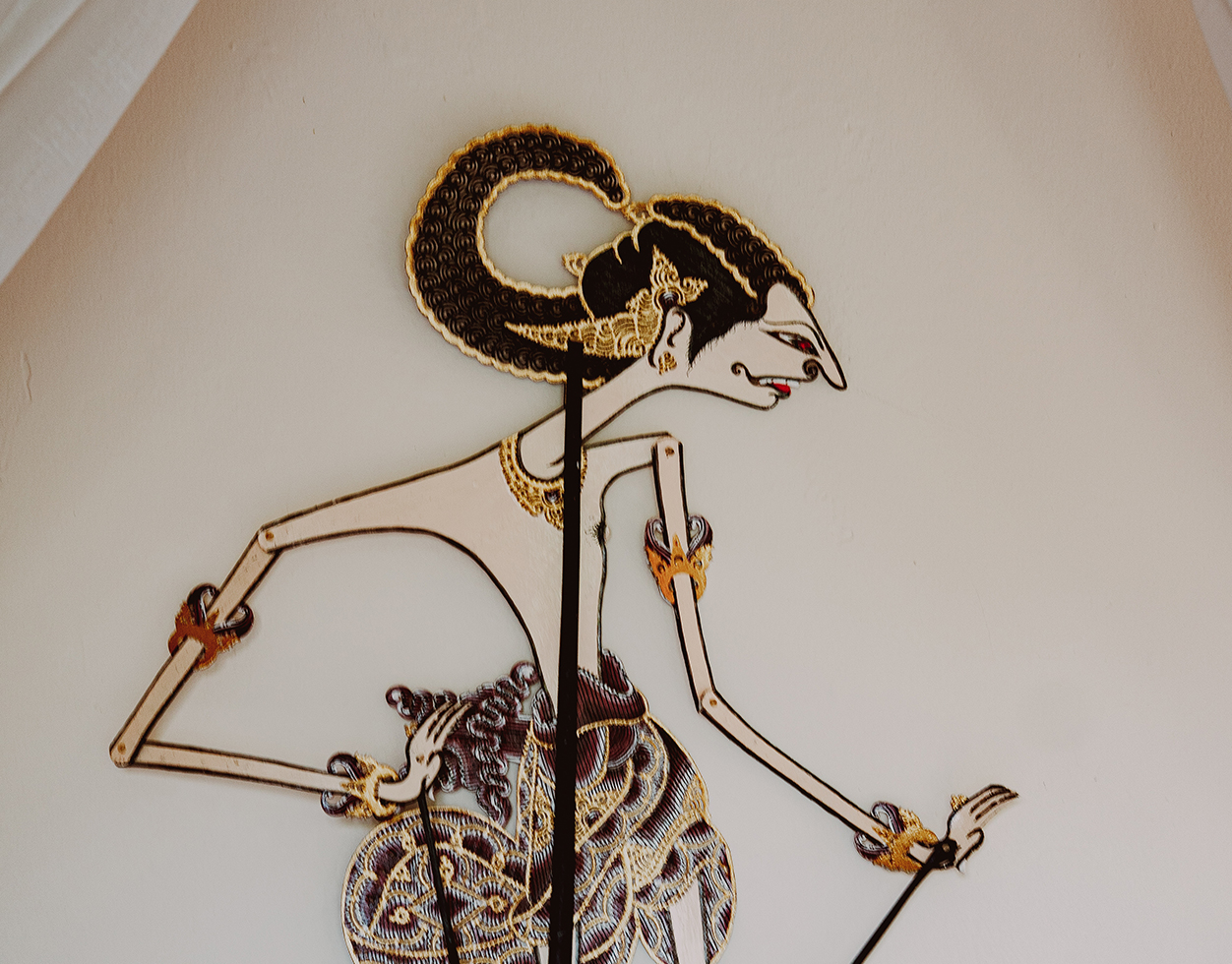
In the Hindu epic Mahabharata, Nakula was the fourth of the five Pandava brothers. Nakula and Sahadewa were twins blessed to Madri, by the Ashvini Kumaras, the divine physicians. Their parents Pandu and Madri died early, so the twins were adopted by their stepmother, Kunti, and were trained by Drona in Hastinapura.
Skilled in Ayurveda, sword fighting, and horse keeping, Nakula is described as the most handsome man in the Mahabharata. Nakula had two wives - Drupadi, the common wife of the five brothers, and Karenumati, daughter of the Chedi king Shishupala. For Yudhishtira's Rajasuya, he conquered the Sivis, the Rohitakas, and other dynasties. After the game of dice, the Pandavas and Drupadi were sent into exile for 13 years with the last year being incognito.
During the incognito, Nakula disguised himself as a horse trainer named Granthika. In the Kurukshetra War, Nakula killed many warriors, including Vrikasura, Shakuni's son.
In Sanskrit, the word Nakula means "mongoose" or "mongoose-colored.
Nakula and his brother Sahadewa are both also referred to in the epic as Āśvineya, Aśvinīsuta, and Aśvisuta because they are the sons of the Ashvins and as Mādravatīputra, Mādravatīsuta, Mādreya, Mādrinandana, Mādrinandanaka, Mādrīputra, Mādrīsuta, Mādrītanūja because they are the sons of Mādrī.
Due to Pandu's inability to bear children (because of the curse of Rishi Kindama), Kunti had to use the boon given by Sage Durvasa to give birth to her three children. She shared the boon with Pandu's second wife, Madri, who invoked the Ashvini Kumaras to beget Nakula and Sahadewa, as twins.
Madri committed self immolation, called Sati when her husband died and entrusted her children's care to Kunti. Despite different divine paternal parentage these five children, first three of Kunti - Yudhistira, Bima and Arjuna- and latter two of Madri - Nakula and Sahadewa, were called Pandavas, or sons of Pandu. Nakula was known to be the most handsome person in the Kuru lineage.
In his childhood, Nakula mastered his skills in fencing and knife throwing under his father Pandu and a hermit named Suka at the Satasringa ashram. Later, Pandu lost his life when he attempted to make love with his wife, Madri.
She committed suicide. Thus, Nakula along with his brothers moved to Hastinapura where he was brought up by Kunti. Kunti loved him as much as her own sons.
Nakula greatly improved his archery and swordplay skills under the tutelage of Drona. Nakula turned out to be an accomplished wielder of the sword. Along with the other Pandava brothers, Nakula was trained in religion, science, administration, and military arts by the Kuru preceptors Kripacharya and Dronacharya. He was particularly skilled at horse-riding.
Nakula's deep understanding of horse breeding and training is documented in the Mahabharata after the death of Narakasura by Krishna. In a conversation with Virata, Nakula claimed to know the art of treating all illnesses of horses. He was also a highly skilled charioteer.
When the Pandavas and their mother, Kunti were in hiding after the event of Lakshagriha, Arjuna won Draupadi's hand in marriage. Nakula married her along with his brothers and had a son, Shatanika who was killed by Ashwatthama in the Kurukshetra War.
He also married Karenumati, the daughter of Shishupala, who bore him one son, Niramitra.
After the war, Yudhistira appointed Nakula as the King of Northern Madra and Sahadewa as King of southern Madra.
Upon the onset of Kali Yuga and the departure of Krishna, the Pandavas retired. Giving up all their belongings and ties, the Pandavas and Drupadi, along with a dog, made their final journey of pilgrimage to the Himalayas.
Except Yudhisthira, all of the Pandavas grew weak and died before reaching heaven. Nakula was the third one to fall after Drupadi and Sahadewa. When Bima asked Yudhistira why Nakula fell, Yudhistira replied that Nakula took pride in his beauty and believed that there was nobody equal to him in looks.

In the Hindu epic Mahabharata, Nakula was the fourth of the five Pandava brothers. Nakula and Sahadewa were twins blessed to Madri, by the Ashvini Kumaras, the divine physicians. Their parents Pandu and Madri died early, so the twins were adopted by their stepmother, Kunti, and were trained by Drona in Hastinapura.
Skilled in Ayurveda, sword fighting, and horse keeping, Nakula is described as the most handsome man in the Mahabharata. Nakula had two wives - Drupadi, the common wife of the five brothers, and Karenumati, daughter of the Chedi king Shishupala. For Yudhishtira's Rajasuya, he conquered the Sivis, the Rohitakas, and other dynasties. After the game of dice, the Pandavas and Drupadi were sent into exile for 13 years with the last year being incognito.
During the incognito, Nakula disguised himself as a horse trainer named Granthika. In the Kurukshetra War, Nakula killed many warriors, including Vrikasura, Shakuni's son.
In Sanskrit, the word Nakula means "mongoose" or "mongoose-colored.
Nakula and his brother Sahadewa are both also referred to in the epic as Āśvineya, Aśvinīsuta, and Aśvisuta because they are the sons of the Ashvins and as Mādravatīputra, Mādravatīsuta, Mādreya, Mādrinandana, Mādrinandanaka, Mādrīputra, Mādrīsuta, Mādrītanūja because they are the sons of Mādrī.
Due to Pandu's inability to bear children (because of the curse of Rishi Kindama), Kunti had to use the boon given by Sage Durvasa to give birth to her three children. She shared the boon with Pandu's second wife, Madri, who invoked the Ashvini Kumaras to beget Nakula and Sahadewa, as twins.
Madri committed self immolation, called Sati when her husband died and entrusted her children's care to Kunti. Despite different divine paternal parentage these five children, first three of Kunti - Yudhistira, Bima and Arjuna- and latter two of Madri - Nakula and Sahadewa, were called Pandavas, or sons of Pandu. Nakula was known to be the most handsome person in the Kuru lineage.
In his childhood, Nakula mastered his skills in fencing and knife throwing under his father Pandu and a hermit named Suka at the Satasringa ashram. Later, Pandu lost his life when he attempted to make love with his wife, Madri.
She committed suicide. Thus, Nakula along with his brothers moved to Hastinapura where he was brought up by Kunti. Kunti loved him as much as her own sons.
Nakula greatly improved his archery and swordplay skills under the tutelage of Drona. Nakula turned out to be an accomplished wielder of the sword. Along with the other Pandava brothers, Nakula was trained in religion, science, administration, and military arts by the Kuru preceptors Kripacharya and Dronacharya. He was particularly skilled at horse-riding.
Nakula's deep understanding of horse breeding and training is documented in the Mahabharata after the death of Narakasura by Krishna. In a conversation with Virata, Nakula claimed to know the art of treating all illnesses of horses. He was also a highly skilled charioteer.
When the Pandavas and their mother, Kunti were in hiding after the event of Lakshagriha, Arjuna won Draupadi's hand in marriage. Nakula married her along with his brothers and had a son, Shatanika who was killed by Ashwatthama in the Kurukshetra War.
He also married Karenumati, the daughter of Shishupala, who bore him one son, Niramitra.
After the war, Yudhistira appointed Nakula as the King of Northern Madra and Sahadewa as King of southern Madra.
Upon the onset of Kali Yuga and the departure of Krishna, the Pandavas retired. Giving up all their belongings and ties, the Pandavas and Drupadi, along with a dog, made their final journey of pilgrimage to the Himalayas.
Except Yudhisthira, all of the Pandavas grew weak and died before reaching heaven. Nakula was the third one to fall after Drupadi and Sahadewa. When Bima asked Yudhistira why Nakula fell, Yudhistira replied that Nakula took pride in his beauty and believed that there was nobody equal to him in looks.
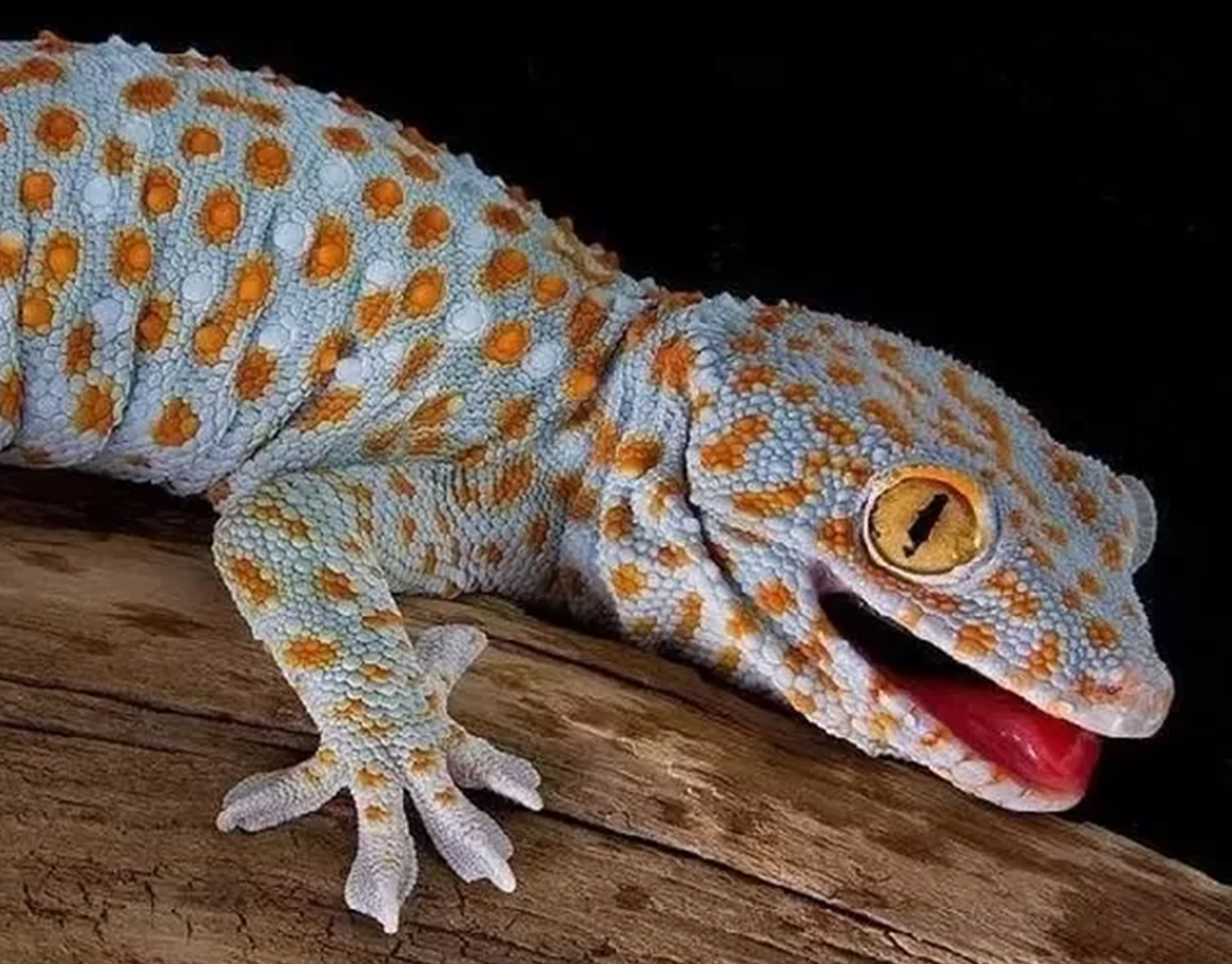
The most common gecko found in Indonesia is the Gekko Gecko. They are nocturnal and often seen at night. This type of gecko is found mainly in Sumatra, Java, Bali, and Lombok. Its native habitat is rainforest, where it lives on trees and cliffs, and it frequently adapts to rural human habitations, roaming walls and ceilings at night in search of insect prey. Their total length (including tail) of 25 – 30 cm (10 –12 inches) on average, but some grow as large as 40 cm (16 inches) long. The skin is soft to the touch and is generally blue-gray with red or orange spots and speckles, but the animal can change the color of its skin to blend into the environment. The animal is derived from the gentle and harmless nature of geckos, which are known for their tame and non-threatening behavior toward humans. The Gekko Gecko feeds on insects and small vertebrates. In captivity, they usually feed on springtails, mealworms, cockroaches, crickets, grasshoppers, pink mice, and locusts. The male's mating call, a loud croak, is variously described as sounding like token, gekk-gekk, tuck-too, túc-key, tou-kay or tokay. A mythical belief among local communities that hearing the sound of a gecko brings good fortune or luck. According to popular belief, encountering the chirping or vocalization of a gecko is considered an auspicious sign and an omen of upcoming positive events or favorable outcomes.

The most common gecko found in Indonesia is the Gekko Gecko. They are nocturnal and often seen at night. This type of gecko is found mainly in Sumatra, Java, Bali, and Lombok. Its native habitat is rainforest, where it lives on trees and cliffs, and it frequently adapts to rural human habitations, roaming walls and ceilings at night in search of insect prey. Their total length (including tail) of 25 – 30 cm (10 –12 inches) on average, but some grow as large as 40 cm (16 inches) long. The skin is soft to the touch and is generally blue-gray with red or orange spots and speckles, but the animal can change the color of its skin to blend into the environment. The animal is derived from the gentle and harmless nature of geckos, which are known for their tame and non-threatening behavior toward humans. The Gekko Gecko feeds on insects and small vertebrates. In captivity, they usually feed on springtails, mealworms, cockroaches, crickets, grasshoppers, pink mice, and locusts. The male's mating call, a loud croak, is variously described as sounding like token, gekk-gekk, tuck-too, túc-key, tou-kay or tokay. A mythical belief among local communities that hearing the sound of a gecko brings good fortune or luck. According to popular belief, encountering the chirping or vocalization of a gecko is considered an auspicious sign and an omen of upcoming positive events or favorable outcomes.

Lizzard is small, mostly carnivorous lizards that have a wide distribution, found on every continent except Antarctica. Belonging to the infraorder Gekkota, lizards are found in warm climates throughout the world.
They range from 1.6 to 60 centimeters (0.6 to 23.6 inches). Their total length (including tail) of 25 – 30 cm (10 –12 inches) on average, but some grow as large as 40 cm (16 inches) long.
Lizzard is unique among lizards for their vocalizations, which differ from species to species. Most Lizzard in the family Gekkonidae use chirping or clicking sounds in their social interactions.
Unlike most lizards, they are usually nocturnal and have excellent night vision; their color vision in low light is 350 times more sensitive than human eyes. The nocturnal lizard evolved from diurnal species, which had lost the rod cells from their eyes.
Many species are well known for their specialized toe pads, which enable them to grab and climb onto smooth and vertical surfaces, and even cross indoor ceilings with ease. This type of animal feeds on insect pests, including moths and mosquitoes.
This Lizard is inspired by the serene and harmless demeanor of lizard, renowned for their gentle and non-aggressive disposition towards humans.

Lizzard is small, mostly carnivorous lizards that have a wide distribution, found on every continent except Antarctica. Belonging to the infraorder Gekkota, lizards are found in warm climates throughout the world.
They range from 1.6 to 60 centimeters (0.6 to 23.6 inches). Their total length (including tail) of 25 – 30 cm (10 –12 inches) on average, but some grow as large as 40 cm (16 inches) long.
Lizzard is unique among lizards for their vocalizations, which differ from species to species. Most Lizzard in the family Gekkonidae use chirping or clicking sounds in their social interactions.
Unlike most lizards, they are usually nocturnal and have excellent night vision; their color vision in low light is 350 times more sensitive than human eyes. The nocturnal lizard evolved from diurnal species, which had lost the rod cells from their eyes.
Many species are well known for their specialized toe pads, which enable them to grab and climb onto smooth and vertical surfaces, and even cross indoor ceilings with ease. This type of animal feeds on insect pests, including moths and mosquitoes.
This Lizard is inspired by the serene and harmless demeanor of lizard, renowned for their gentle and non-aggressive disposition towards humans.
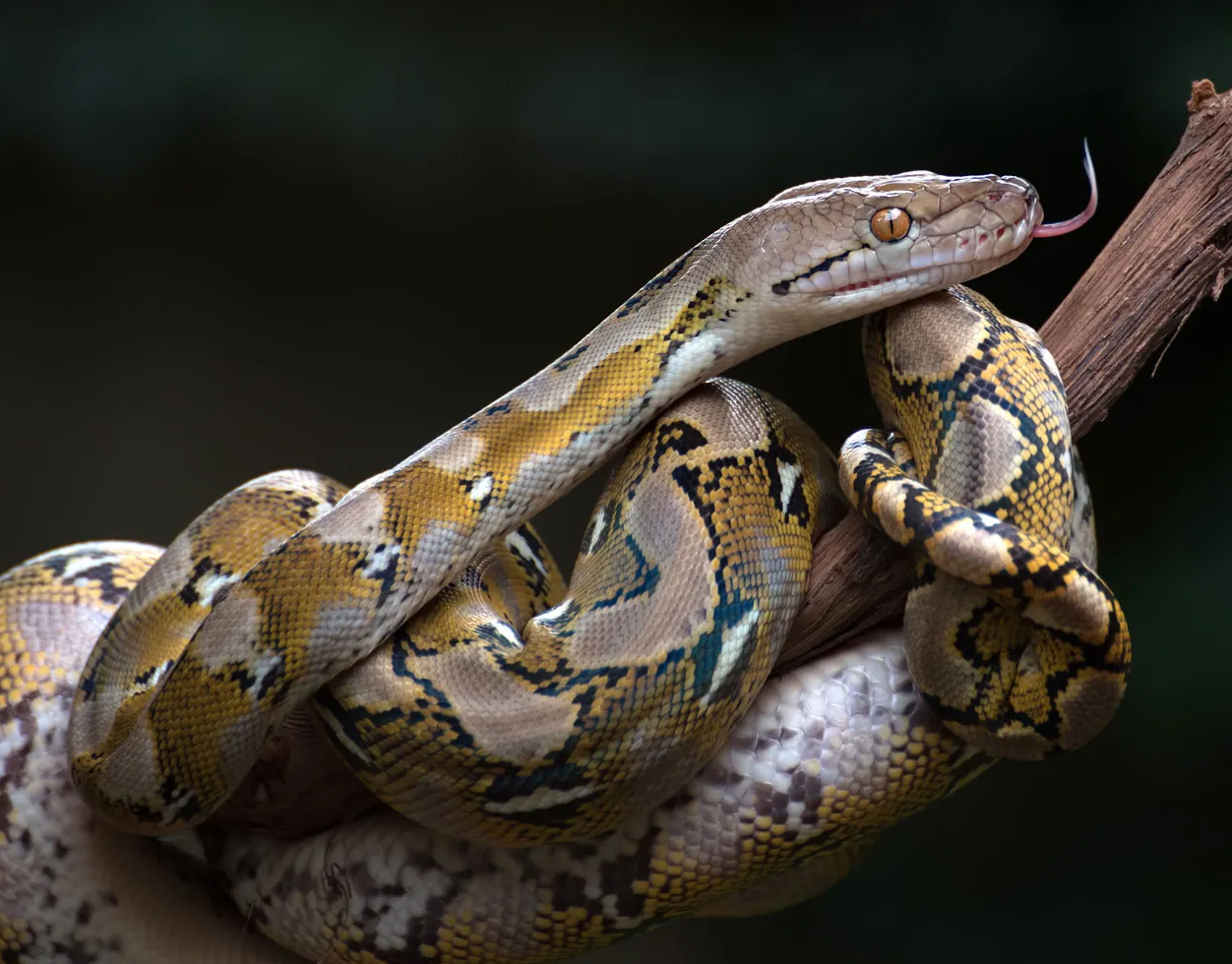
Ular Sawah, also known as Python Reticulatus, is a species of snake native to Southeast Asia, including countries such as Indonesia, Malaysia, and Thailand. They belongs to the family Pythonidae and is one of the largest snake species in the world. These snakes are attracted to the abundant prey found in rice fields, such as rodents and birds. Their presence in rice fields can help control rodent populations, encounters with humans in these areas should be approached with caution. Here are some tips to help avoid snake encounters or handle them appropriately:
Stay Calm - If you see a snake, try to remain calm and avoid sudden movements or loud noises.
Most snakes prefer to avoid confrontation and will only bite if they feel threatened or cornered.
Give Them Space - Give the snake plenty of space and do not attempt to handle or provoke it. Maintain a safe distance and observe from a far.
Be Mindful of Their Environment - Snakes may be found in various habitats, including tall grass, rocky areas, or near water sources. Be cautious when walking through these environments and watch your step.
Use Proper Lighting - In areas where snake encounters are more likely, it is advisable to use a flashlight or headlamp during nighttime walks to increase visibility and avoid accidental contact.

Ular Sawah, also known as Python Reticulatus, is a species of snake native to Southeast Asia, including countries such as Indonesia, Malaysia, and Thailand. They belongs to the family Pythonidae and is one of the largest snake species in the world. These snakes are attracted to the abundant prey found in rice fields, such as rodents and birds. Their presence in rice fields can help control rodent populations, encounters with humans in these areas should be approached with caution. Here are some tips to help avoid snake encounters or handle them appropriately:
Stay Calm - If you see a snake, try to remain calm and avoid sudden movements or loud noises.
Most snakes prefer to avoid confrontation and will only bite if they feel threatened or cornered.
Give Them Space - Give the snake plenty of space and do not attempt to handle or provoke it. Maintain a safe distance and observe from a far.
Be Mindful of Their Environment - Snakes may be found in various habitats, including tall grass, rocky areas, or near water sources. Be cautious when walking through these environments and watch your step.
Use Proper Lighting - In areas where snake encounters are more likely, it is advisable to use a flashlight or headlamp during nighttime walks to increase visibility and avoid accidental contact.
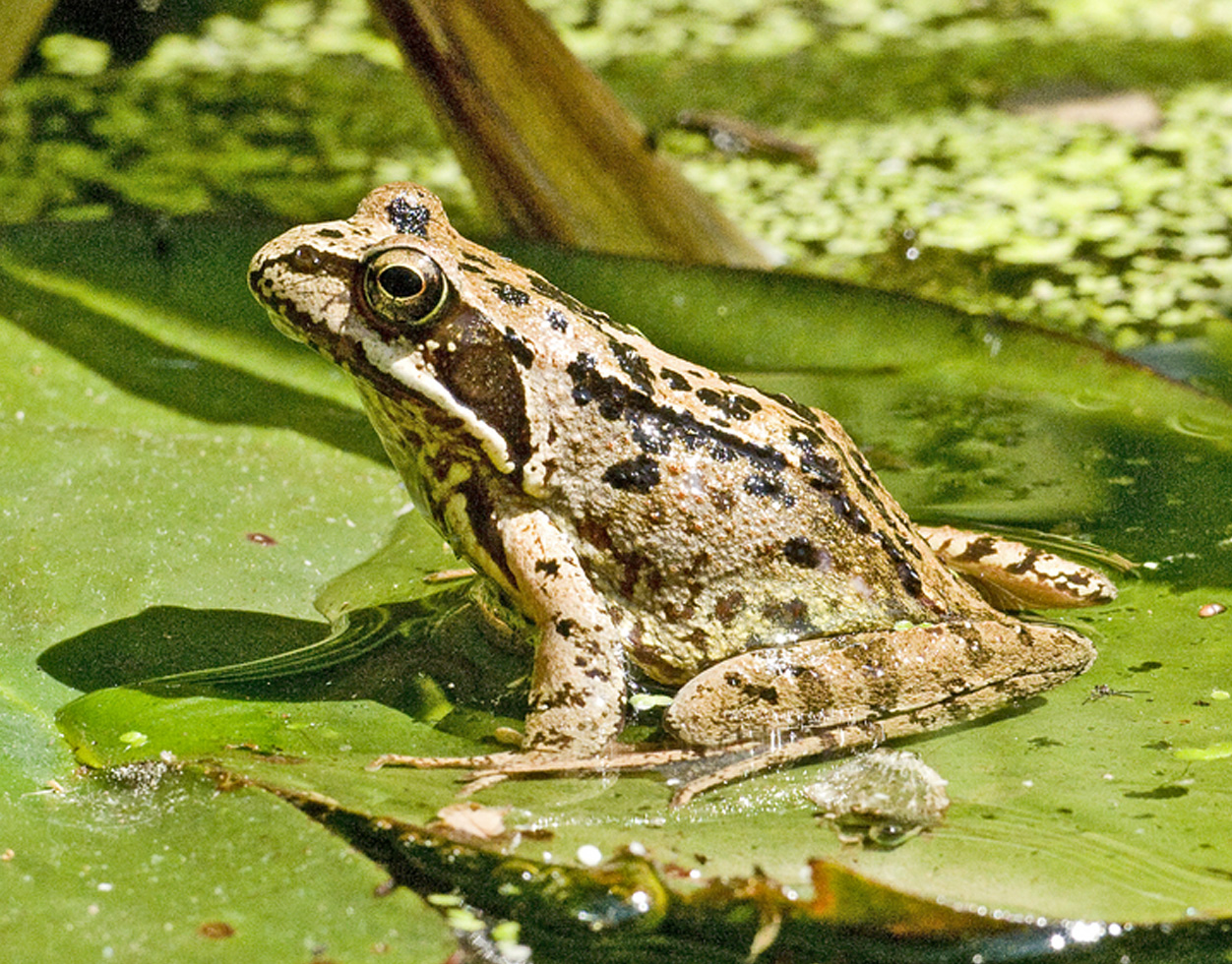
A frog is any member of a diverse and largely carnivorous group of short-bodied, tailless amphibians composing the order Anura. Frogs are widely distributed, ranging from the tropics to subarctic regions, but the greatest concentration of species diversity is in tropical rainforests. Frogs account for around 88% of extant amphibian species. They are also one of the five most diverse vertebrate orders.
Frogs have glandular skin, with secretions ranging from distasteful to toxic. Their skin varies in colour from well-camouflaged dappled brown, grey, and green to vivid patterns of bright red or yellow and black to show toxicity and ward off predators. Adult frogs live in fresh water and on dry land; some species are adapted for living underground or in trees.The eyes of most frogs are located on either side of the head near the top and project outwards as hemispherical bulges. They provide binocular vision over a field of 100° to the front and a total visual field of almost 360°. Frogs can hear both in the air and below water.
Frogs are carnivorous animals and their diet primarily consists of small invertebrates and insects. Some common prey items for frogs include insects like flies, mosquitoes, beetles, and spiders. They also feed on worms, snails, small fish, tadpoles, and even other smaller frogs. Frogs have a specialized tongue that they use to catch their prey, flicking it out rapidly to capture insects and pulling them back into their mouths. Their diet may vary depending on their species, habitat, and availability of food sources.
The organism is a product of the mild and harmless disposition of animals, recognized for their gentle and non-menacing conduct in relation to humans.

A frog is any member of a diverse and largely carnivorous group of short-bodied, tailless amphibians composing the order Anura. Frogs are widely distributed, ranging from the tropics to subarctic regions, but the greatest concentration of species diversity is in tropical rainforests. Frogs account for around 88% of extant amphibian species. They are also one of the five most diverse vertebrate orders.
Frogs have glandular skin, with secretions ranging from distasteful to toxic. Their skin varies in colour from well-camouflaged dappled brown, grey, and green to vivid patterns of bright red or yellow and black to show toxicity and ward off predators. Adult frogs live in fresh water and on dry land; some species are adapted for living underground or in trees.The eyes of most frogs are located on either side of the head near the top and project outwards as hemispherical bulges. They provide binocular vision over a field of 100° to the front and a total visual field of almost 360°. Frogs can hear both in the air and below water.
Frogs are carnivorous animals and their diet primarily consists of small invertebrates and insects. Some common prey items for frogs include insects like flies, mosquitoes, beetles, and spiders. They also feed on worms, snails, small fish, tadpoles, and even other smaller frogs. Frogs have a specialized tongue that they use to catch their prey, flicking it out rapidly to capture insects and pulling them back into their mouths. Their diet may vary depending on their species, habitat, and availability of food sources.
The organism is a product of the mild and harmless disposition of animals, recognized for their gentle and non-menacing conduct in relation to humans.
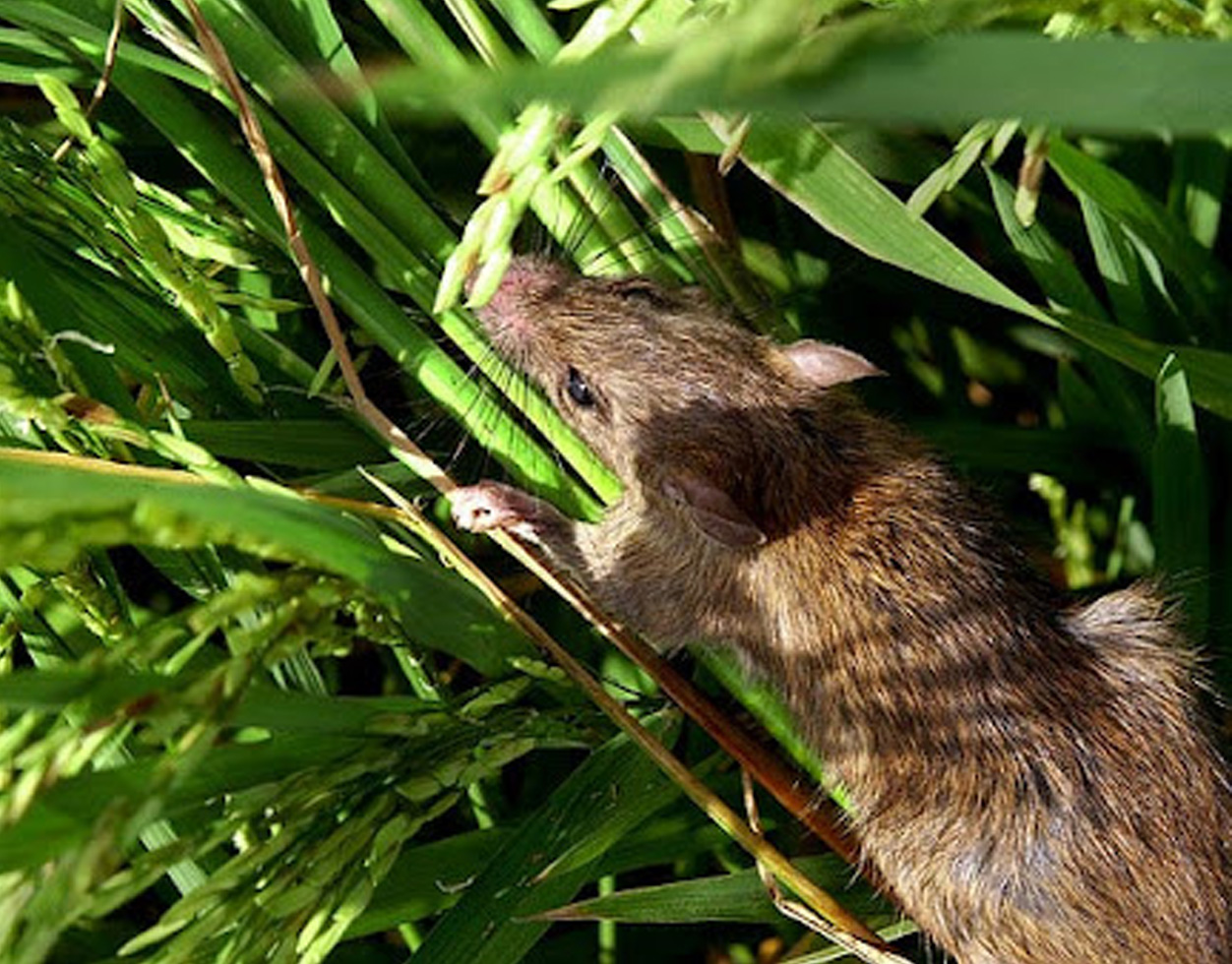
The ricefield rat (Rattus argentiventer) is a species of rat found throughout Southeast Asia.
The ricefield rat is a medium-sized rat with a grizzled yellow-brown and black pelage. Its belly is gray in the midline with whiter flanks. The tail is uniformly medium brown. They have chisel-like incisor.
The ricefield rat is between 304–400 mm long with a tail length of 140–200 mm and a skull length of 37–41 mm. The average weight of Rattus Argentiventer is around 97 to 219 gr. Female have 12 mammae. Young have an
orange-colored tuft in front of each ear.
The ricefield rat lives in large groups which consist of a dominant male and high ranking female. When attacked or disturbed they will make squeals and whistles sound. Rattus Argentiventer's main diet includes termites, insects, grasshopper, snails, seeds, nuts, rice, vegetables, and fruits.
They feed at night and actively moving at dusk and dawn. During daytime, they can be seen among vegetation, weeds or maturing field. It undergoes 3 week gestation giving birth about 5 to 10 young per litters.
The creature is derived from the docile and benign nature of animals, known for their domesticated and non-aggressive behavior towards humans.

The ricefield rat (Rattus argentiventer) is a species of rat found throughout Southeast Asia.
The ricefield rat is a medium-sized rat with a grizzled yellow-brown and black pelage. Its belly is gray in the midline with whiter flanks. The tail is uniformly medium brown. They have chisel-like incisor.
The ricefield rat is between 304–400 mm long with a tail length of 140–200 mm and a skull length of 37–41 mm. The average weight of Rattus Argentiventer is around 97 to 219 gr. Female have 12 mammae. Young have an
orange-colored tuft in front of each ear.
The ricefield rat lives in large groups which consist of a dominant male and high ranking female. When attacked or disturbed they will make squeals and whistles sound. Rattus Argentiventer's main diet includes termites, insects, grasshopper, snails, seeds, nuts, rice, vegetables, and fruits.
They feed at night and actively moving at dusk and dawn. During daytime, they can be seen among vegetation, weeds or maturing field. It undergoes 3 week gestation giving birth about 5 to 10 young per litters.
The creature is derived from the docile and benign nature of animals, known for their domesticated and non-aggressive behavior towards humans.
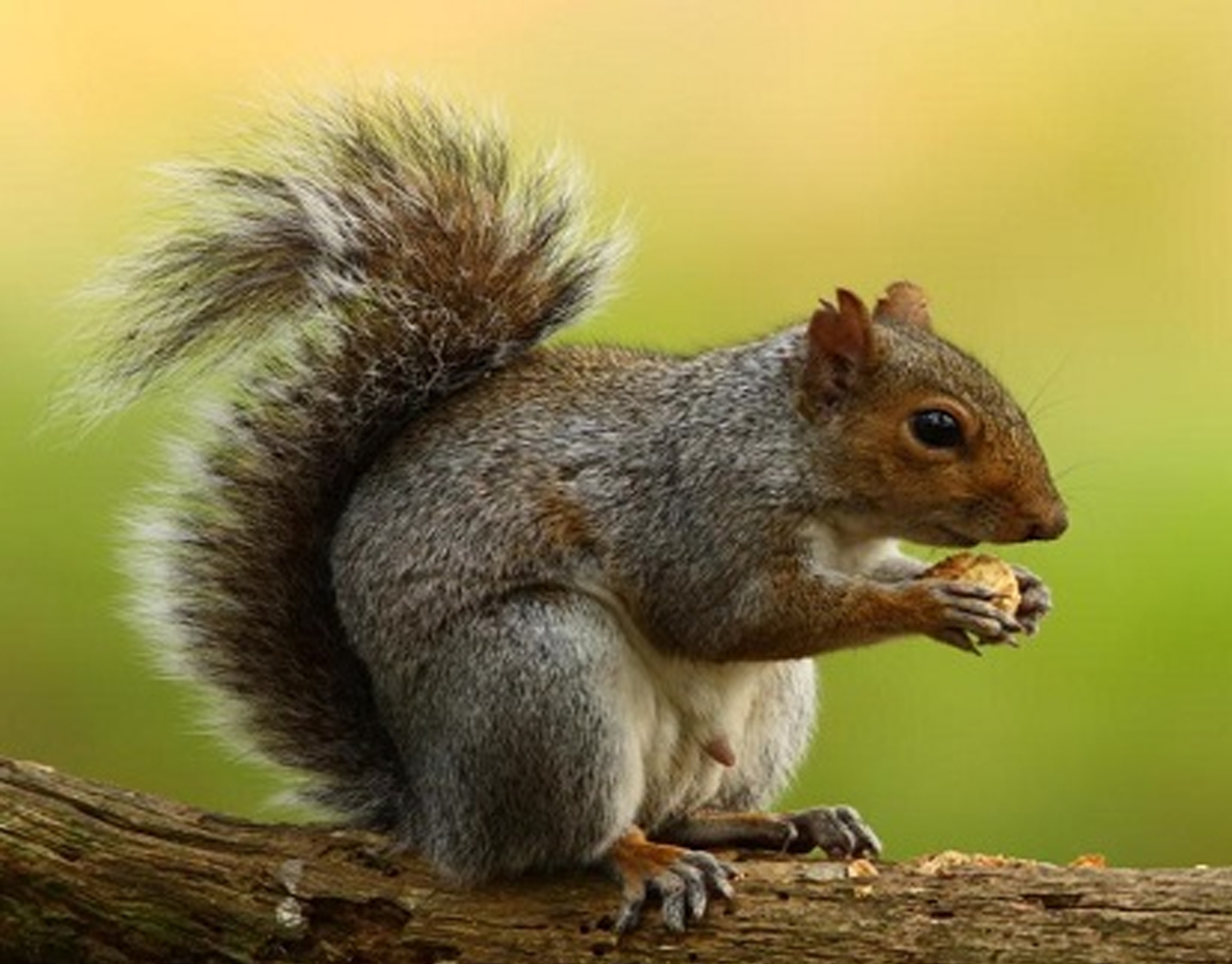
Squirrels are members of the family Sciuridae, a family that includes small or medium-size rodents. The squirrel family includes tree squirrels, ground squirrels (including chipmunks and prairie dogs, among others), and flying squirrels. Squirrels typically have slender bodies with very long very bushy tails and large eyes. In general, their fur is soft and silky, though much thicker in some species than others.
Squirrels live in almost every habitat, from tropical rainforest to semiarid desert, avoiding only the high polar regions and the driest of deserts. As their large eyes indicate, squirrels have an excellent sense of vision, which is especially important for the tree-dwelling species. Many also have a good sense of touch, with vibrissae on their limbs as well as their heads.
Because squirrels cannot digest cellulose, they must rely on foods rich in protein, carbohydrates, and fats. In temperateregions, early spring is the hardest time of year for squirrels because the nuts they buried are beginning to sprout (and thus are no longer available to eat), while many of the usual food sources are not yet available. During these times, squirrels rely heavily on tree buds. Squirrels, being primarily herbivores, eat a wide variety of plants, as well as nuts, seeds, conifer cones, fruits, fungi, and green vegetation. Some squirrels, however, also consume meat, especially when faced with hunger. Squirrels have been known to eat small birds, young snakes, and smaller rodents, as well as bird eggs and insects. Some tropical squirrel species have shifted almost entirely to a diet of insects.
The organism is a product of the mild and harmless disposition of animals, recognized for their gentle and non-menacing conduct in relation to humans.

Squirrels are members of the family Sciuridae, a family that includes small or medium-size rodents. The squirrel family includes tree squirrels, ground squirrels (including chipmunks and prairie dogs, among others), and flying squirrels. Squirrels typically have slender bodies with very long very bushy tails and large eyes. In general, their fur is soft and silky, though much thicker in some species than others.
Squirrels live in almost every habitat, from tropical rainforest to semiarid desert, avoiding only the high polar regions and the driest of deserts. As their large eyes indicate, squirrels have an excellent sense of vision, which is especially important for the tree-dwelling species. Many also have a good sense of touch, with vibrissae on their limbs as well as their heads.
Because squirrels cannot digest cellulose, they must rely on foods rich in protein, carbohydrates, and fats. In temperateregions, early spring is the hardest time of year for squirrels because the nuts they buried are beginning to sprout (and thus are no longer available to eat), while many of the usual food sources are not yet available. During these times, squirrels rely heavily on tree buds. Squirrels, being primarily herbivores, eat a wide variety of plants, as well as nuts, seeds, conifer cones, fruits, fungi, and green vegetation. Some squirrels, however, also consume meat, especially when faced with hunger. Squirrels have been known to eat small birds, young snakes, and smaller rodents, as well as bird eggs and insects. Some tropical squirrel species have shifted almost entirely to a diet of insects.
The organism is a product of the mild and harmless disposition of animals, recognized for their gentle and non-menacing conduct in relation to humans.
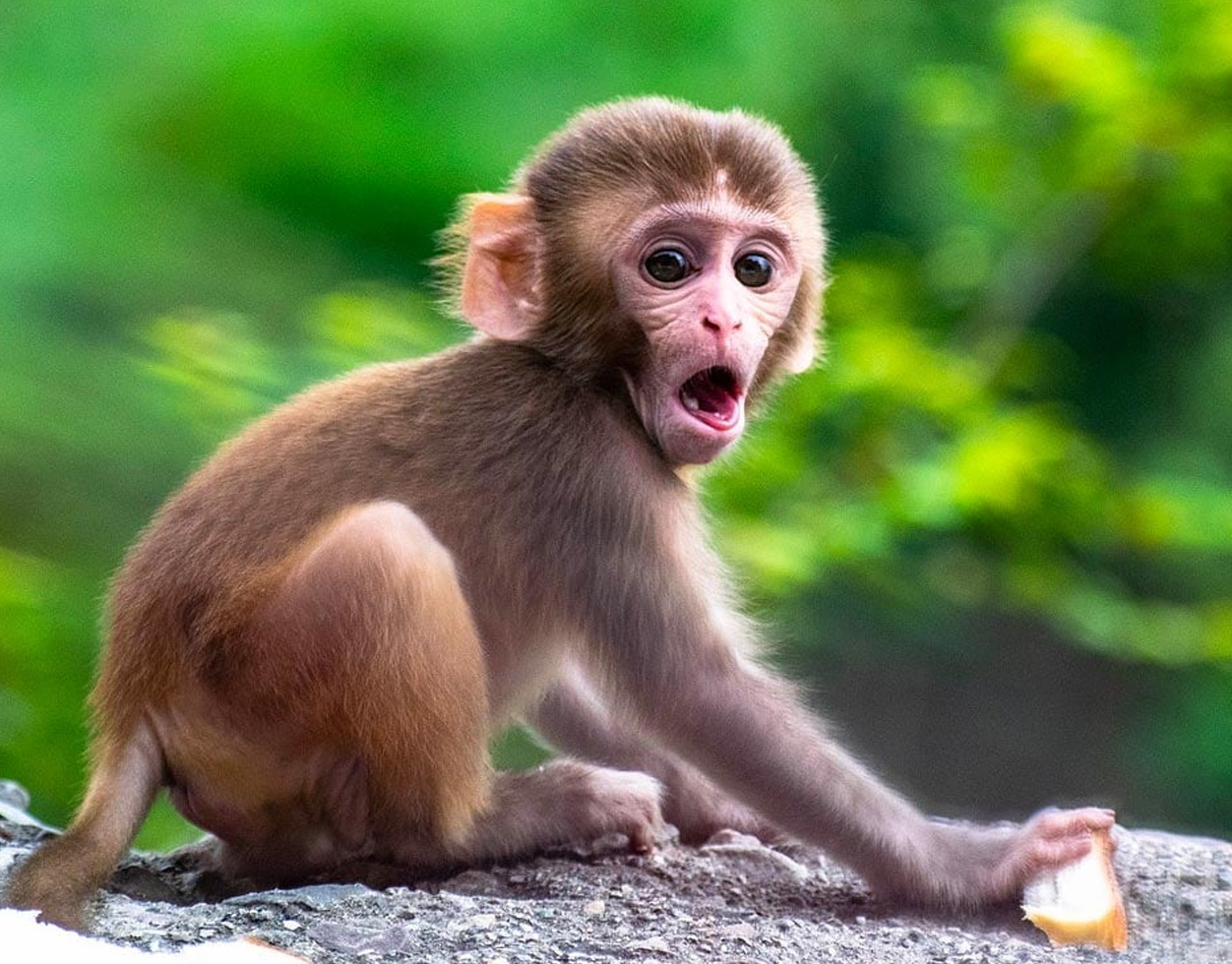
Monkey is a common name that may refer to most mammals of the infraorder Simiiformes, also known as the simians. Traditionally, all animals in the group now known as simians are counted as monkeys except the apes, which constitutes an incomplete paraphyletic grouping; however, in the broader sense based on cladistics, apes (Hominoidea) are also included, making the terms monkeys and simians synonyms in regard to their scope.
Monkeys range in size from the pygmy marmoset, which can be as small as 117 mm (4+5⁄8 in) with a 172 mm (6+3⁄4 in) tail and just over 100 g (3+1⁄2 oz) in weight, to the male mandrill, almost 1 m (3 ft 3 in) long and weighing up to 36 kg (79 lb). Some are arboreal (living in trees) while others live on the savanna; diets differ among the various species but may contain any of the following: fruit, leaves, seeds, nuts, flowers, eggs and small animals (including insects and spiders).
Monkey is the symbol of fourth Tirthankara in Jainism, Abhinandananatha. Hanuman, a prominent deity in Hinduism, is a human-like monkey god who is believed to bestow courage, strength, and longevity to the person who thinks about him or Rama. In Buddhism, the monkey is an early incarnation of Buddha but may also represent trickery and ugliness. The Chinese Buddhist "mind monkey" metaphor refers to the unsettled, restless state of human mind. Monkey is also one of the Three Senseless Creatures, symbolizing greed, with the tiger representing anger and the deer lovesickness.

Monkey is a common name that may refer to most mammals of the infraorder Simiiformes, also known as the simians. Traditionally, all animals in the group now known as simians are counted as monkeys except the apes, which constitutes an incomplete paraphyletic grouping; however, in the broader sense based on cladistics, apes (Hominoidea) are also included, making the terms monkeys and simians synonyms in regard to their scope.
Monkeys range in size from the pygmy marmoset, which can be as small as 117 mm (4+5⁄8 in) with a 172 mm (6+3⁄4 in) tail and just over 100 g (3+1⁄2 oz) in weight, to the male mandrill, almost 1 m (3 ft 3 in) long and weighing up to 36 kg (79 lb). Some are arboreal (living in trees) while others live on the savanna; diets differ among the various species but may contain any of the following: fruit, leaves, seeds, nuts, flowers, eggs and small animals (including insects and spiders).
Monkey is the symbol of fourth Tirthankara in Jainism, Abhinandananatha. Hanuman, a prominent deity in Hinduism, is a human-like monkey god who is believed to bestow courage, strength, and longevity to the person who thinks about him or Rama. In Buddhism, the monkey is an early incarnation of Buddha but may also represent trickery and ugliness. The Chinese Buddhist "mind monkey" metaphor refers to the unsettled, restless state of human mind. Monkey is also one of the Three Senseless Creatures, symbolizing greed, with the tiger representing anger and the deer lovesickness.
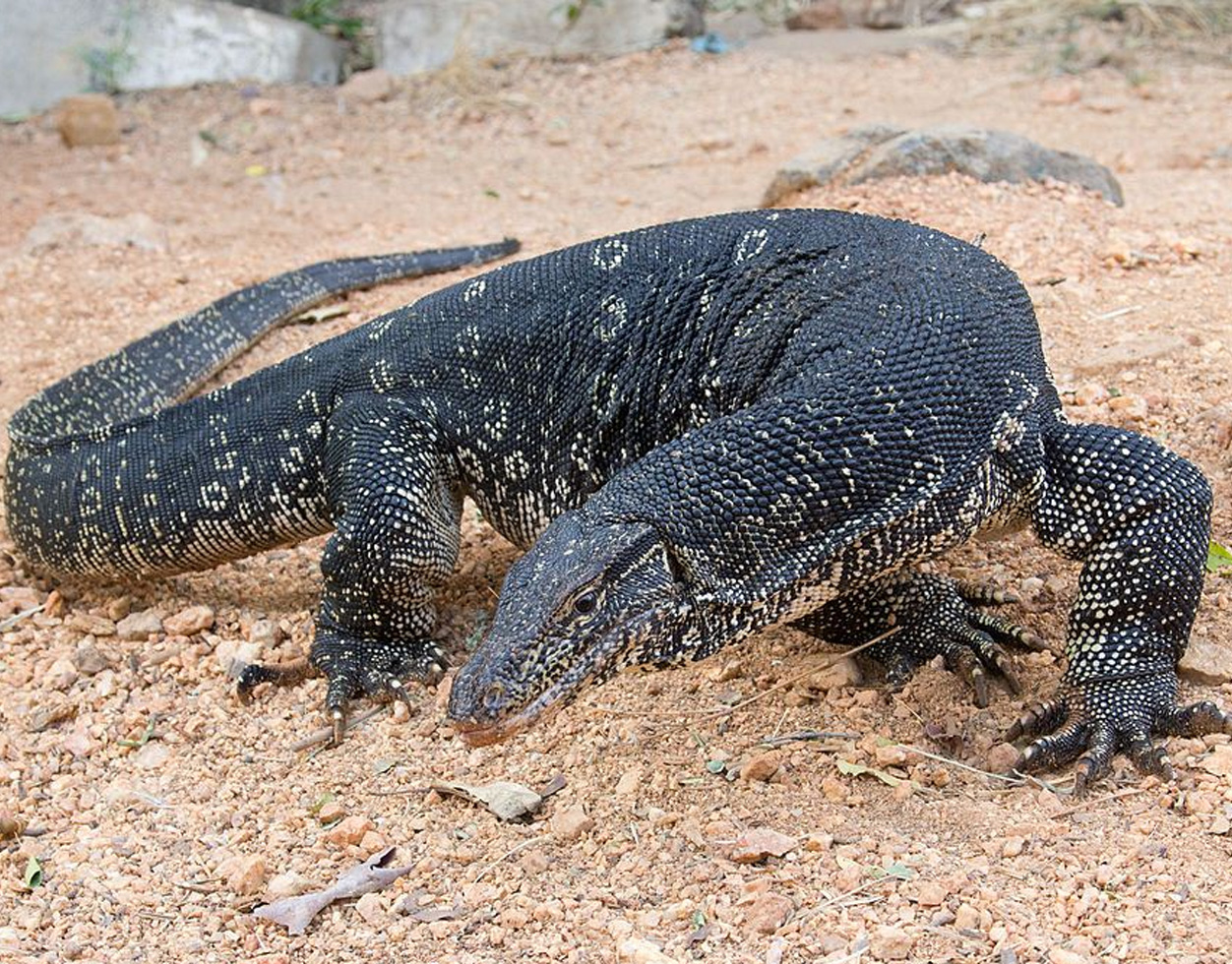
Monitor lizards are lizards in the genus Varanus, the only extant genus in the family Varanidae. Monitor lizards have long necks, powerful tails and claws, and well-developed limbs. The adult length of extant species ranges from 20 cm (7.9 in) in some species such as Varanus sparnus, to over 3 m (10 ft) in the case of the Komodo dragon, though the extinct varanid known as megalania (Varanus priscus) may have been capable of reaching lengths more than 7 m (23 ft).
Most monitor lizards are almost entirely carnivorous, consuming prey as varied as insects, crustaceans, arachnids, myriapods, mollusks, fish, amphibians, reptiles, birds, and mammals. Most species feed on invertebrates as juveniles and shift to feeding on vertebrates as adults. Deer make up about 50% of the diet of adults of the largest species, Varanus komodoensis. In contrast, three arboreal species from the Philippines, Varanus bitatawa, Varanus mabitang, and Varanus olivaceus, are primarily fruit eaters. Although normally solitary, groups as large as 25 individual monitor lizards are common in ecosystems that have limited water resources.
The creature is derived from the docile and benign nature of animals, known for their domesticated and non-aggressive behavior towards humans.

Monitor lizards are lizards in the genus Varanus, the only extant genus in the family Varanidae. Monitor lizards have long necks, powerful tails and claws, and well-developed limbs. The adult length of extant species ranges from 20 cm (7.9 in) in some species such as Varanus sparnus, to over 3 m (10 ft) in the case of the Komodo dragon, though the extinct varanid known as megalania (Varanus priscus) may have been capable of reaching lengths more than 7 m (23 ft).
Most monitor lizards are almost entirely carnivorous, consuming prey as varied as insects, crustaceans, arachnids, myriapods, mollusks, fish, amphibians, reptiles, birds, and mammals. Most species feed on invertebrates as juveniles and shift to feeding on vertebrates as adults. Deer make up about 50% of the diet of adults of the largest species, Varanus komodoensis. In contrast, three arboreal species from the Philippines, Varanus bitatawa, Varanus mabitang, and Varanus olivaceus, are primarily fruit eaters. Although normally solitary, groups as large as 25 individual monitor lizards are common in ecosystems that have limited water resources.
The creature is derived from the docile and benign nature of animals, known for their domesticated and non-aggressive behavior towards humans.
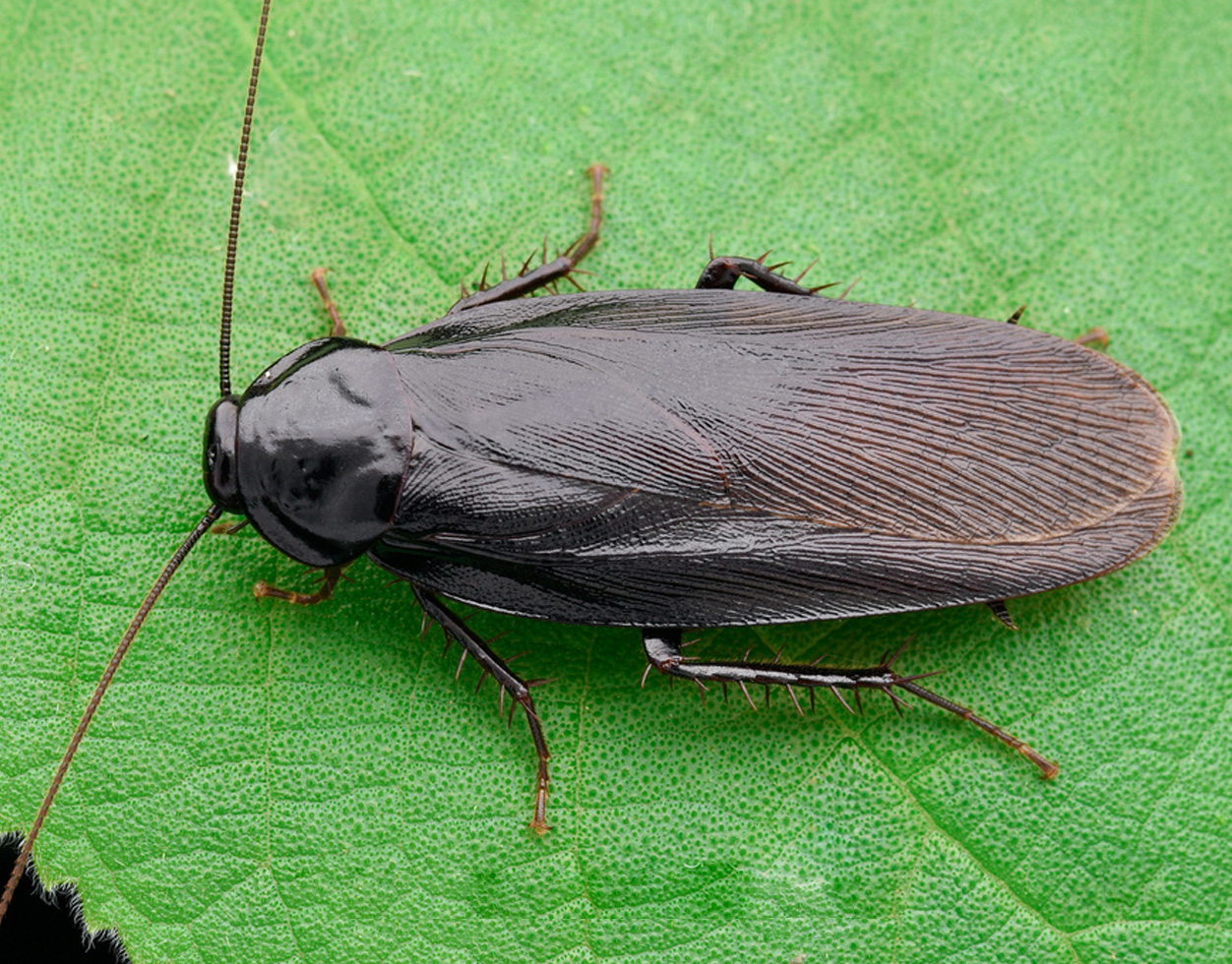
Periplaneta Svenhedini is a species of cockroach commonly found in tropical environments, including the lush surroundings of our resort. Unlike the more familiar cockroaches that are typically seen indoors, Periplaneta Svenhedini prefers outdoor, humid habitats, especially near vegetation like coconut palms. This species has a reddish-brown body and long wings, which it uses to fly short distances, usually when disturbed. Although it may look intimidating, Periplaneta svenhedini is completely harmless and plays an important role in the ecosystem by helping to decompose organic matter, contributing to the natural cycle of life.
Being nocturnal, this cockroach is most active during the evening, seeking shelter under leaves or tree bark. It’s not a household pest and generally doesn’t venture indoors, so sightings around the resort grounds, particularly in the evenings, are not uncommon. Its presence is a natural part of the tropical environment that surrounds Visesa Resort, a reminder of the diverse wildlife thriving in the area.
We take great care to manage outdoor pests, but guests may occasionally notice one of these creatures as part of the vibrant ecosystem. We appreciate your understanding, as these insects are an integral part of the natural beauty around us. Should you encounter any issues, our team is always available to assist and ensure your comfort during your stay.

Periplaneta Svenhedini is a species of cockroach commonly found in tropical environments, including the lush surroundings of our resort. Unlike the more familiar cockroaches that are typically seen indoors, Periplaneta Svenhedini prefers outdoor, humid habitats, especially near vegetation like coconut palms. This species has a reddish-brown body and long wings, which it uses to fly short distances, usually when disturbed. Although it may look intimidating, Periplaneta svenhedini is completely harmless and plays an important role in the ecosystem by helping to decompose organic matter, contributing to the natural cycle of life.
Being nocturnal, this cockroach is most active during the evening, seeking shelter under leaves or tree bark. It’s not a household pest and generally doesn’t venture indoors, so sightings around the resort grounds, particularly in the evenings, are not uncommon. Its presence is a natural part of the tropical environment that surrounds Visesa Resort, a reminder of the diverse wildlife thriving in the area.
We take great care to manage outdoor pests, but guests may occasionally notice one of these creatures as part of the vibrant ecosystem. We appreciate your understanding, as these insects are an integral part of the natural beauty around us. Should you encounter any issues, our team is always available to assist and ensure your comfort during your stay.
.jpg)
Ants are a natural part of the tropical environment and can sometimes be seen around the resort, especially near sweet foods or sugary items. These small insects are highly social creatures that live in well-organized colonies, often foraging in search of food. The ants commonly found here are harmless and do not pose any danger to guests. They are naturally drawn to anything sweet, so we recommend keeping food covered and disposing of leftovers properly to minimize their presence. While we take measures to manage their numbers, occasional sightings are a normal part of being in a lush, tropical setting. Should you need any assistance, our team is always happy to help.
.jpg)
Ants are a natural part of the tropical environment and can sometimes be seen around the resort, especially near sweet foods or sugary items. These small insects are highly social creatures that live in well-organized colonies, often foraging in search of food. The ants commonly found here are harmless and do not pose any danger to guests. They are naturally drawn to anything sweet, so we recommend keeping food covered and disposing of leftovers properly to minimize their presence. While we take measures to manage their numbers, occasional sightings are a normal part of being in a lush, tropical setting. Should you need any assistance, our team is always happy to help.

Lady Finger bananas (also known as sugar bananas, fig bananas, or date bananas) are diploid cultivarsof Musa acuminata. They are small, thin skinned, and sweet.
Lady Finger bananas trees can grow at a height of 7.5 meters (25 ft). Its pseudostem is slender and streaked with reddish brown, but it has a heavy root system that makes it resistant to wind damage. It is resistant to drought and Black Weevil, but is susceptible to Sigatoka. It blooms during mid-summer, late summer, and early fall. It is monocarpic and is propagated asexually.
The fruit is 4 to 5 inches (10 to 12+1⁄2 cm) in length, and light yellow. The skin is thin and the flesh is sweet. 12 to 20 fingers are borne in each hand, with each bunch typically having 10 to 14 hands.
How to open:

Lady Finger bananas (also known as sugar bananas, fig bananas, or date bananas) are diploid cultivarsof Musa acuminata. They are small, thin skinned, and sweet.
Lady Finger bananas trees can grow at a height of 7.5 meters (25 ft). Its pseudostem is slender and streaked with reddish brown, but it has a heavy root system that makes it resistant to wind damage. It is resistant to drought and Black Weevil, but is susceptible to Sigatoka. It blooms during mid-summer, late summer, and early fall. It is monocarpic and is propagated asexually.
The fruit is 4 to 5 inches (10 to 12+1⁄2 cm) in length, and light yellow. The skin is thin and the flesh is sweet. 12 to 20 fingers are borne in each hand, with each bunch typically having 10 to 14 hands.
How to open:

"Buah salju," also known as 'Ice Cream Bean' in English, is a fruit found mainly in the Bedugul region of Indonesia but is also abundant in South America. The snow fruit is native to the Amazon rainforest and typically grows to a height of over 20 meters, reaching up to approximately 30 meters. It thrives in tropical climates and can even tolerate colder conditions.
Despite its unique nature, the snow fruit offers various benefits that are good for the body. There are five main benefits of this fruit. Firstly, it contains vitamin A, which is beneficial for maintaining healthy eyesight. Secondly, snow fruit has a distinctive taste and is low in calories, making it a popular choice as a dessert or snack. Additionally, it is low in cholesterol, making it suitable for individuals with high cholesterol levels.One of the essential organs in the human body is the heart, and it is crucial to maintain its health from an early stage. Besides adopting a healthy lifestyle and diet, consuming snow fruit is an easy way to promote heart health. It can help alleviate high cholesterol levels, which can lead to various severe health conditions.

"Buah salju," also known as 'Ice Cream Bean' in English, is a fruit found mainly in the Bedugul region of Indonesia but is also abundant in South America. The snow fruit is native to the Amazon rainforest and typically grows to a height of over 20 meters, reaching up to approximately 30 meters. It thrives in tropical climates and can even tolerate colder conditions.
Despite its unique nature, the snow fruit offers various benefits that are good for the body. There are five main benefits of this fruit. Firstly, it contains vitamin A, which is beneficial for maintaining healthy eyesight. Secondly, snow fruit has a distinctive taste and is low in calories, making it a popular choice as a dessert or snack. Additionally, it is low in cholesterol, making it suitable for individuals with high cholesterol levels.One of the essential organs in the human body is the heart, and it is crucial to maintain its health from an early stage. Besides adopting a healthy lifestyle and diet, consuming snow fruit is an easy way to promote heart health. It can help alleviate high cholesterol levels, which can lead to various severe health conditions.
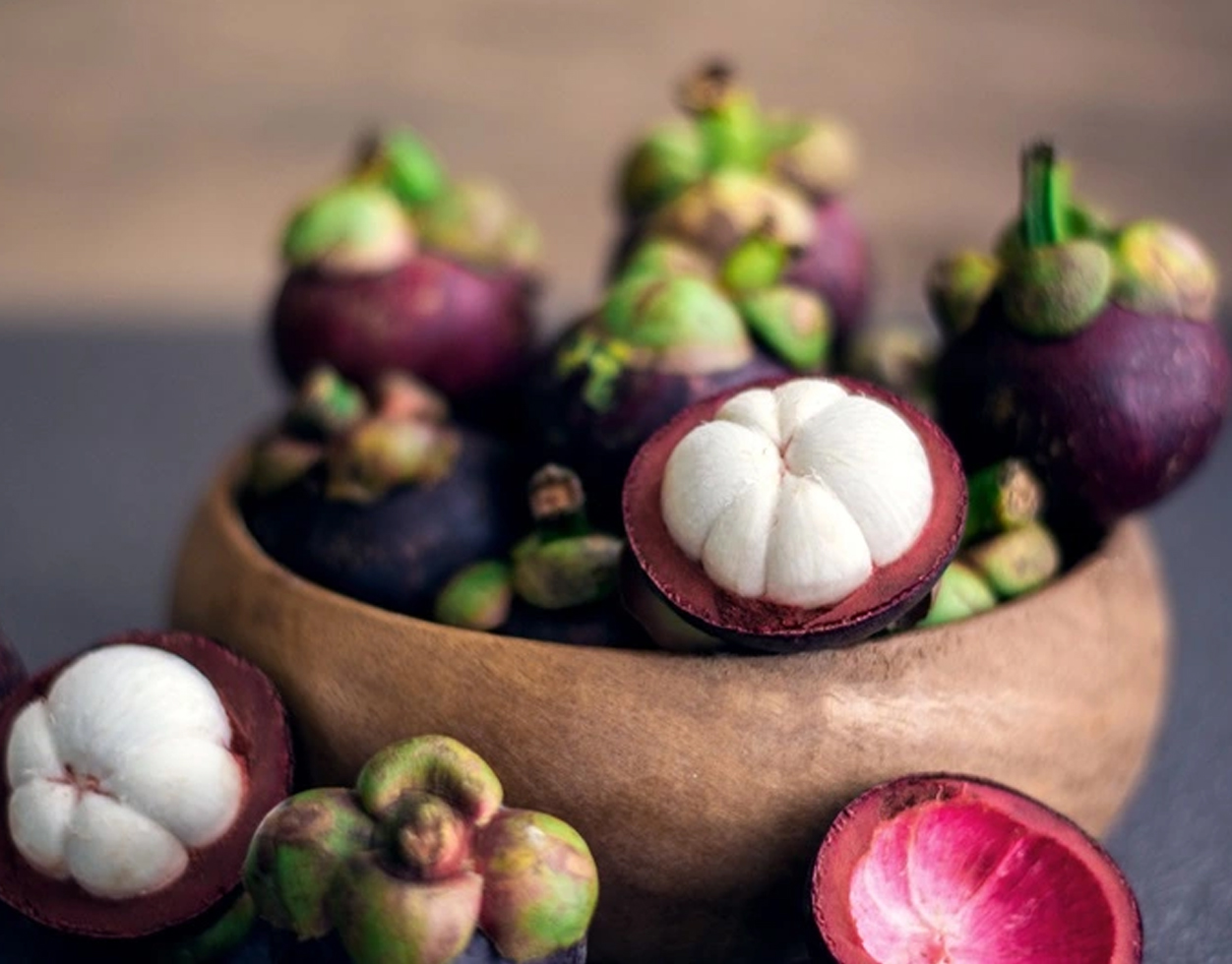
Mangosteen (Garcinia Mangostana) is a tropical evergreen tree with edible fruit native to tropical lands surrounding the Indian Ocean. Its origin is uncertain due to widespread prehistoric cultivation. It grows mainly in Southeast Asia, southwest India and other tropical areas such as Colombia and Puerto Rico, where the tree has been introduced.
The fruit of the mangosteen is sweet and tangy, juicy, somewhat fibrous, with fluid-filled vesicles
(like the flesh of citrus fruits), with an inedible, deep reddish-purple colored rind (exocarp) when ripe.
The seeds are of similar size and shape to almonds.

Mangosteen (Garcinia Mangostana) is a tropical evergreen tree with edible fruit native to tropical lands surrounding the Indian Ocean. Its origin is uncertain due to widespread prehistoric cultivation. It grows mainly in Southeast Asia, southwest India and other tropical areas such as Colombia and Puerto Rico, where the tree has been introduced.
The fruit of the mangosteen is sweet and tangy, juicy, somewhat fibrous, with fluid-filled vesicles
(like the flesh of citrus fruits), with an inedible, deep reddish-purple colored rind (exocarp) when ripe.
The seeds are of similar size and shape to almonds.

Salak (Salacca Zalacca) is a species of palm tree (family Arecaceae) native to Java and Sumatra
in Indonesia. It is cultivated in other regions of Indonesia as a food crop, and reportedly
naturalized in Bali, Lombok, Timor, Maluku, and Sulawesi.
It is a very short-stemmed palm, with leaves up to 6 meters (20 ft) long; each leaf has a 2-meter long petiole with spines up to 15 centimeters (5.9 in) long, and numerous leaflets. The fruits grow in clusters at the base of the palm, and are also known as snakeskin fruit due to the reddish-brown scaly skin. They are about the size and shape of a ripe fig, with a distinct tip. The pulp is edible. The fruit can be peeled by pinching the tip, which should cause the skin to slough off so it can be pulled away. The fruit inside consists of three lobes with the two larger ones, or even all three, containing a large inedible seed. The lobes resemble, and have the consistency of, large peeled garlic cloves. The taste is usually sweet and acidic, with a strong astringent edge, but its apple-like texture can vary from very dry and crumbly (salak pondoh from Yogyakarta) to moist and crunchy (salak Bali).

Salak (Salacca Zalacca) is a species of palm tree (family Arecaceae) native to Java and Sumatra
in Indonesia. It is cultivated in other regions of Indonesia as a food crop, and reportedly
naturalized in Bali, Lombok, Timor, Maluku, and Sulawesi.
It is a very short-stemmed palm, with leaves up to 6 meters (20 ft) long; each leaf has a 2-meter long petiole with spines up to 15 centimeters (5.9 in) long, and numerous leaflets. The fruits grow in clusters at the base of the palm, and are also known as snakeskin fruit due to the reddish-brown scaly skin. They are about the size and shape of a ripe fig, with a distinct tip. The pulp is edible. The fruit can be peeled by pinching the tip, which should cause the skin to slough off so it can be pulled away. The fruit inside consists of three lobes with the two larger ones, or even all three, containing a large inedible seed. The lobes resemble, and have the consistency of, large peeled garlic cloves. The taste is usually sweet and acidic, with a strong astringent edge, but its apple-like texture can vary from very dry and crumbly (salak pondoh from Yogyakarta) to moist and crunchy (salak Bali).
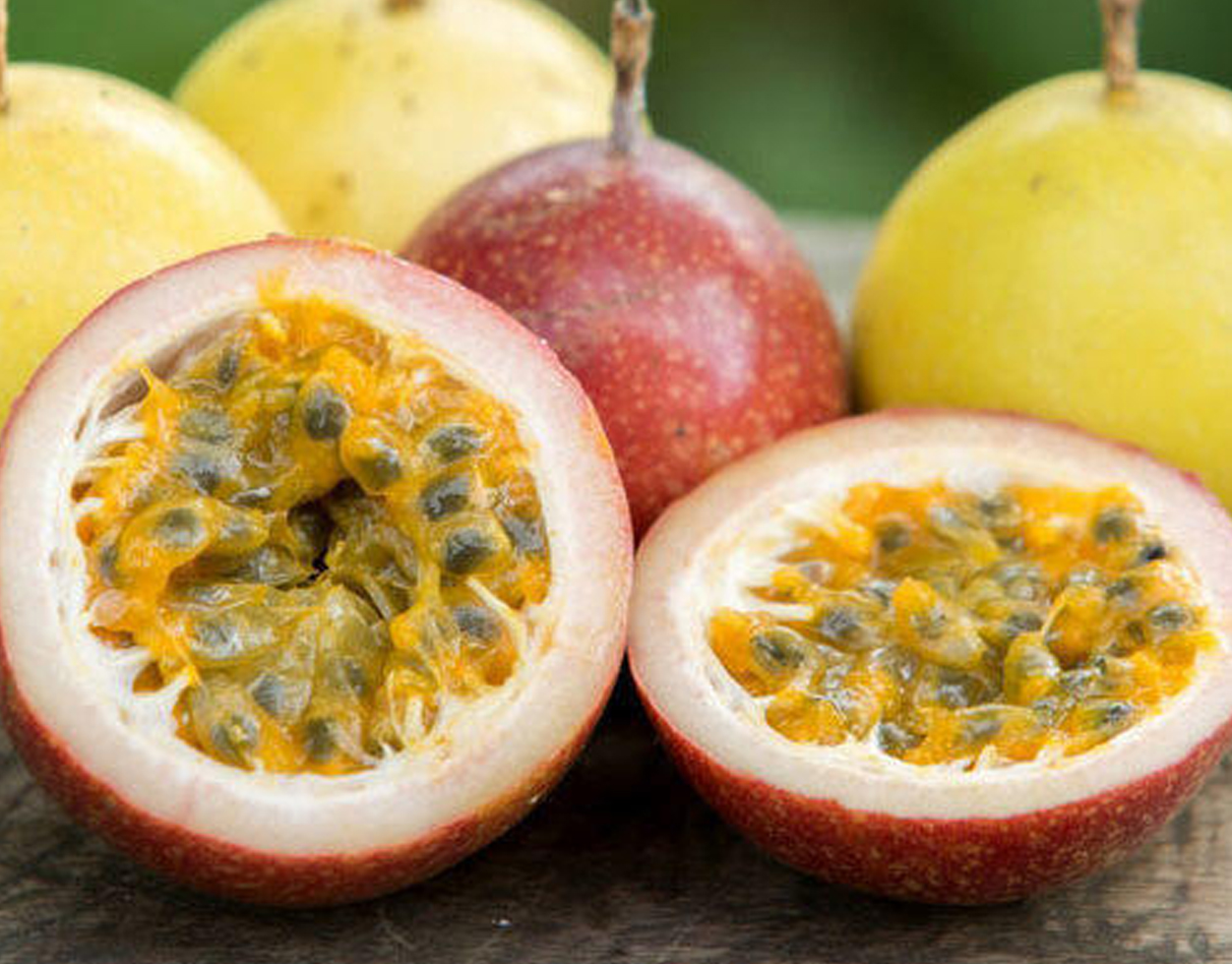
Passiflora edulis, commonly known as passion fruit, is a vine species of passion flower native to southern Brazil. It is cultivated commercially in tropical and subtropical areas for its sweet, seedy fruit. The fruit is a pepo, a type of berry, round to oval, either yellow or dark purple at maturity, with a soft to firm, juicy interior filled with numerous seeds. The fruit is both eaten and juiced, with the juice often added to other fruit juices to enhance aroma. There are two main varieties: a purple-fruited type, P. edulis f. edulis, and the yellow-fruited P. edulis f. flavicarpa.
In Indonesia, where it is known as markisa, both edulis and flavicarpa varieties are cultivated and consumed differently. The former is normally eaten straight as is, while the latter is more commonly strained to obtain its juice, which is cooked with sugar to make passionfruit syrup used in drinks and desserts.

Passiflora edulis, commonly known as passion fruit, is a vine species of passion flower native to southern Brazil. It is cultivated commercially in tropical and subtropical areas for its sweet, seedy fruit. The fruit is a pepo, a type of berry, round to oval, either yellow or dark purple at maturity, with a soft to firm, juicy interior filled with numerous seeds. The fruit is both eaten and juiced, with the juice often added to other fruit juices to enhance aroma. There are two main varieties: a purple-fruited type, P. edulis f. edulis, and the yellow-fruited P. edulis f. flavicarpa.
In Indonesia, where it is known as markisa, both edulis and flavicarpa varieties are cultivated and consumed differently. The former is normally eaten straight as is, while the latter is more commonly strained to obtain its juice, which is cooked with sugar to make passionfruit syrup used in drinks and desserts.
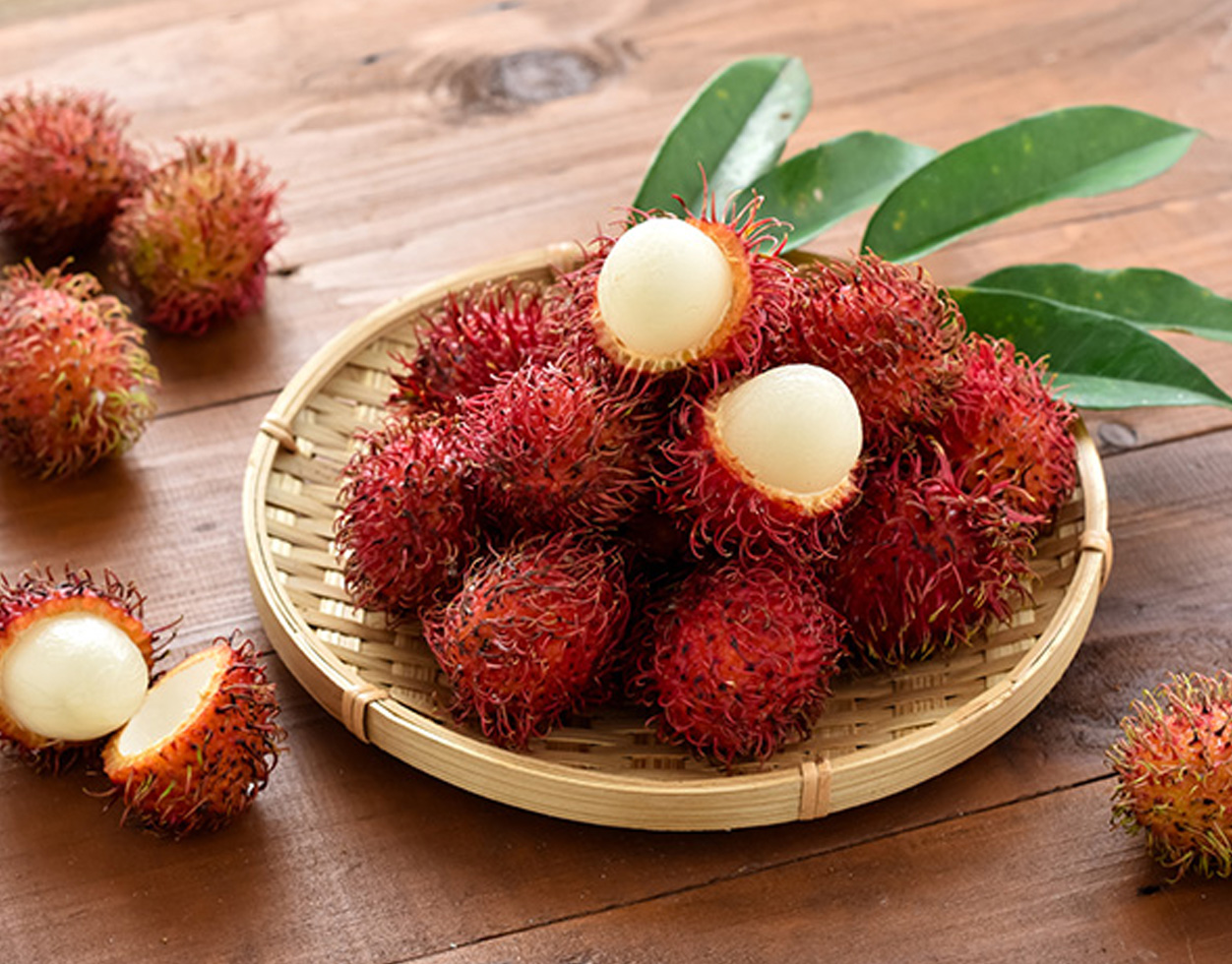
Rambutan (Nephelium lappaceum) is a medium-sized tropical tree in the family Sapindaceae. The name also refers to the edible fruit produced by this tree. The rambutan is native to Southeast Asia. It is closely related
to several other edible tropical fruits including the lychee, longan, pulasan and guinep.
It is an evergreen tree growing to a height of 15–24 metres (49–79 ft). The leaves are alternate, 14–30 cm long, pinnate, with three to 11 leaflets, each leaflet 5–15 cm wide and 3–10 cm broad, with an entire margin.The fruit is a round to oval single-seeded drupe, 3–6 cm long and 3–4 cm broad, borne in a loose pendant cluster of 10–20 together. The leathery skin is reddish and covered with fleshy pliable spines, hence the name, which means 'hairs'. The spines (also known as "spinterns") contribute to the transpiration of the fruit, which can affect the fruit's quality.
The single seed is glossy brown, 1–1.3 cm, with a white basal scar. Soft and containing equal portions of saturated and unsaturated fats, the seed may be cooked and eaten, but is bitter and has narcotic properties.

Rambutan (Nephelium lappaceum) is a medium-sized tropical tree in the family Sapindaceae. The name also refers to the edible fruit produced by this tree. The rambutan is native to Southeast Asia. It is closely related
to several other edible tropical fruits including the lychee, longan, pulasan and guinep.
It is an evergreen tree growing to a height of 15–24 metres (49–79 ft). The leaves are alternate, 14–30 cm long, pinnate, with three to 11 leaflets, each leaflet 5–15 cm wide and 3–10 cm broad, with an entire margin.The fruit is a round to oval single-seeded drupe, 3–6 cm long and 3–4 cm broad, borne in a loose pendant cluster of 10–20 together. The leathery skin is reddish and covered with fleshy pliable spines, hence the name, which means 'hairs'. The spines (also known as "spinterns") contribute to the transpiration of the fruit, which can affect the fruit's quality.
The single seed is glossy brown, 1–1.3 cm, with a white basal scar. Soft and containing equal portions of saturated and unsaturated fats, the seed may be cooked and eaten, but is bitter and has narcotic properties.

Dimocarpus longan, commonly known as the longan and dragon's eye, is a tropical tree species that produces edible fruit. It is one of the better-known tropical members of the soapberry family Sapindaceae, to which the lychee and rambutan also belong.The fruit of the longan is similar to that of the lychee, but less aromatic in taste. It is native to tropical Asia and China.
The longan (from Cantonese lùhng-ngáahn literally 'dragon eye'), is so named because it resembles an eyeball when its fruit is shelled (the black seed shows through the translucent flesh like a pupil and iris). The seed is small, round, and hard, and of an enamel-like, lacquered black. The fully ripened, freshly harvested fruit has a bark-like shell, thin, and firm, making the fruit easy to peel by squeezing the pulp out as if one were "cracking" a sunflower seed. When the shell has more moisture content and is more tender, the fruit becomes less convenient to shell. The tenderness of the shell varies due to either premature harvest, variety, weather conditions or storage conditions.

Dimocarpus longan, commonly known as the longan and dragon's eye, is a tropical tree species that produces edible fruit. It is one of the better-known tropical members of the soapberry family Sapindaceae, to which the lychee and rambutan also belong.The fruit of the longan is similar to that of the lychee, but less aromatic in taste. It is native to tropical Asia and China.
The longan (from Cantonese lùhng-ngáahn literally 'dragon eye'), is so named because it resembles an eyeball when its fruit is shelled (the black seed shows through the translucent flesh like a pupil and iris). The seed is small, round, and hard, and of an enamel-like, lacquered black. The fully ripened, freshly harvested fruit has a bark-like shell, thin, and firm, making the fruit easy to peel by squeezing the pulp out as if one were "cracking" a sunflower seed. When the shell has more moisture content and is more tender, the fruit becomes less convenient to shell. The tenderness of the shell varies due to either premature harvest, variety, weather conditions or storage conditions.

The tangerine is a type of citrus fruit that is orange in color, that is considered either a variety of
Citrus reticulata, the mandarin orange, or a closely related species, under the name Citrus tangerina, or yet as a hybrid (Citrus × tangerina) of mandarin orange varieties, with some pomelo contribution.
Tangerines are smaller and less rounded than the oranges. The taste is considered less sour, as well as sweeter and stronger, than that of an orange. A ripe tangerine is firm to slightly soft, and pebbly-skinned with no deep grooves, as well as orange in color. The peel is thin, with little bitter white mesocarp. All of these traits are shared by mandarins generally.
Peak tangerine season lasts from autumn to spring. Tangerines are most commonly peeled and eaten by hand. The fresh fruit is also used in salads, desserts and main dishes. Tangerines contain 85% water, 13% carbohydrates, and negligible amounts of fat and protein (table). Among micronutrients, only vitamin C is in significant content (32% of the Daily Value) in a 100-gram (3.5 oz) reference serving, with all other nutrients in low amounts.

The tangerine is a type of citrus fruit that is orange in color, that is considered either a variety of
Citrus reticulata, the mandarin orange, or a closely related species, under the name Citrus tangerina, or yet as a hybrid (Citrus × tangerina) of mandarin orange varieties, with some pomelo contribution.
Tangerines are smaller and less rounded than the oranges. The taste is considered less sour, as well as sweeter and stronger, than that of an orange. A ripe tangerine is firm to slightly soft, and pebbly-skinned with no deep grooves, as well as orange in color. The peel is thin, with little bitter white mesocarp. All of these traits are shared by mandarins generally.
Peak tangerine season lasts from autumn to spring. Tangerines are most commonly peeled and eaten by hand. The fresh fruit is also used in salads, desserts and main dishes. Tangerines contain 85% water, 13% carbohydrates, and negligible amounts of fat and protein (table). Among micronutrients, only vitamin C is in significant content (32% of the Daily Value) in a 100-gram (3.5 oz) reference serving, with all other nutrients in low amounts.

Silakan putar perangkat ke posisi potrait.
Untuk pengalaman terbaik, gunakan perangkat Anda dalam Potrait.
